 31/10/2009 01:17 31/10/2009 01:17 |
|
| | | OFFLINE | | Post: 18.764
Post: 1.412 | Registrato il: 28/08/2005
Registrato il: 20/01/2009 | Administratore | Utente Veteran | |
|

 To the new ambassador from Panama:
To the new ambassador from Panama:
'Stability of moral values
dignifies society'

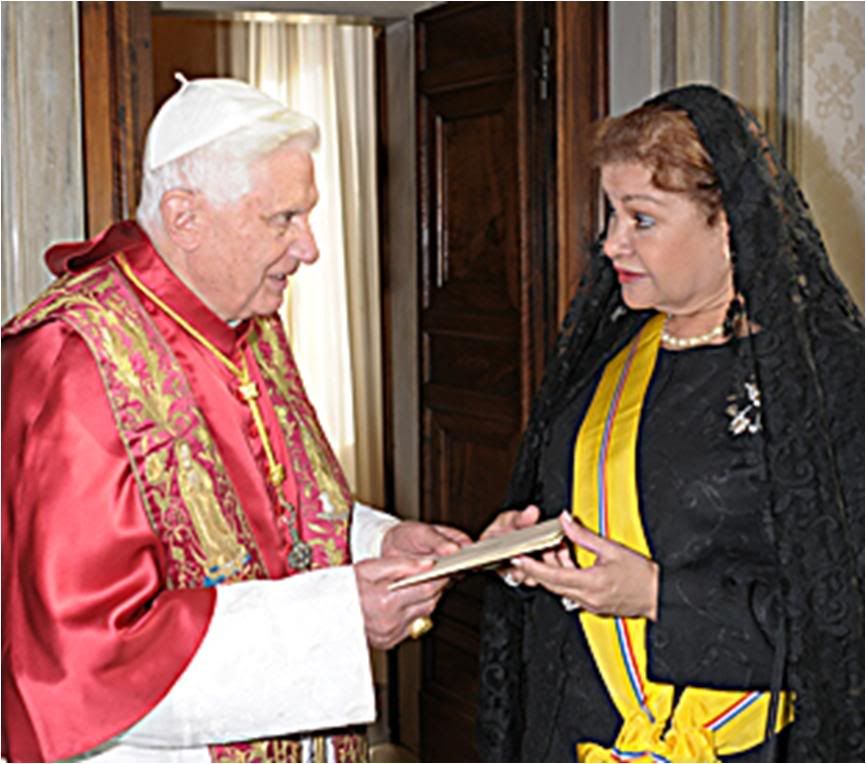
VATICAN CITY, 30 OCT 2009 (VIS) - Today the Holy Father received the credentials of the new ambassador of Panama, Delia Cardenas Christie.
In his address, the Pope highlighted that "the identity of Panama, which for centuries has been forged as a mosaic of ethnicities, peoples, and cultures, presents itself as an eloquent sign to the human family that peaceful co-existence between persons of diverse origins in a climate of communion and cooperation is possible".
In this sense, he encouraged all its citizens "to work toward greater social, economic, and cultural equality between the distinct sectors of society, renouncing selfish interests, strengthening solidarity, and reconciling wills, so that, in the words of Pope Paul VI, 'the scandal of glaring inequalities' might be uprooted."
The Pope emphasized that "the Gospel message has played an essential and constructive role in shaping Panama's identity, forming part of the nation's spiritual patrimony and cultural heritage".
"The Church's presence holds particular relevance in the area of education and in assisting the poor, the sick, the weak, the imprisoned, and immigrants, as well as in the defence of aspects as basic as the commitment to social justice, the fight against corruption, the work toward peace, the inviolability of the right to life from the moment of conception until natural death as well as in safeguarding the family based on marriage between a man and a woman. These are irreplaceable elements for creating a healthy social fabric and building a dynamic society, precisely because of the stability of the moral values sustaining, ennobling, and dignifying it".
The Pope continually referred to the commitment of Panamanian authorities "in strengthening democratic institutions and public life rooted upon strong ethical pillars. In this respect they have spared no efforts to promote an efficient and independent juridical system and to act in all areas with honor, transparency in community activism, and professionalism and diligence in resolving the problems affecting the citizens. This will favor the development of a just and fraternal society in which no sector of the population is forgotten or doomed to violence or marginalization".
"The valuable role Panama is playing in the political stability of Central America bears noting," he highlighted, "in moments where the current situation shows how the consistent and harmonic progress of the human community does not depend solely on economic development or technological discoveries".
The Holy Father concluded by pointing out that "these aspects necessarily have to be carried out with those of an ethical and spiritual nature because a society advances primarily when in it abounds in persons with inner righteousness, faultless conduct, and the resolute will to work toward the common good, and who also impart to further generations a true humanism, sown within the family and cultivated at school so that the welfare of the nation be the fruit of the fundamental growth of the person and of all persons".
[Modificato da TERESA BENEDETTA 31/10/2009 02:21] |
| |
|
| |
 31/10/2009 13:59 31/10/2009 13:59 |
|
| | | OFFLINE | | Post: 18.765
Post: 1.413 | Registrato il: 28/08/2005
Registrato il: 20/01/2009 | Administratore | Utente Veteran | |
|
 Spanish writer Jose Luis Restan is the director general of programming content for COPE, Spain's largest radio network. Last year, he published a book on Benedict XVI called Diario de un Pontificado, and before that he wrote one on the Catholic faith called La Osadia de Creer [The Audacity of Belief]. He writes a regular column for Paginas Digital, a daily online journal in Spanish.
The Pope's passion for unity
Spanish writer Jose Luis Restan is the director general of programming content for COPE, Spain's largest radio network. Last year, he published a book on Benedict XVI called Diario de un Pontificado, and before that he wrote one on the Catholic faith called La Osadia de Creer [The Audacity of Belief]. He writes a regular column for Paginas Digital, a daily online journal in Spanish.
The Pope's passion for unity
by Jose Luis Restan

29/10/2009
As Providence would have it, a few days after the announcement of an open door for Anglican faithful wishing to return to the Church of Rome, the VAtican began Rome with representatives of the Priestly Fraternity of St. Pius X (FSSPX) to clarify doctrinal points that have kept the followers of Mons. Marcel Lefebvre apart from Rome since 1988.
At the same time, in Cyprus, the mixed Catholic-Orthodox commission for theological dialog started to examine the crucial question of the role of the Papacy in a reunified Church.
It is not yet time to blow the trumpets. The path to unity has no shortcuts - it will be long and painful. And it will not be surprising if even the real steps forward in recent days will lead to new bottlenecks.
We see it in the Anglican world, where there has been no lack of bitter invective against Benedict XVI for his generosity, seen by some as an opportunistic move to avail of the internal weakness of Anglicanism.
It happened in Cyprus where the shrill protests from the monks of Mt. Athos and other ultra-conservative Orthodox circles protested the ecumenical dialog as a surrender by the Orthodox hierarchy to the Bishop of Rome.
But, as always, the saddest news comes from within the Catholic Church itself. There has been no lack of a whispering campaign by those who disapprove of the Pope's decision with regard to the Anglicans.
Some find the situation disturbing because it changes the status quo of the ecumenical dialog, and others because it would introduce the novelty of married priests [which is not unprecedented - it has been tried successully with Episcopalian clergy who became Catholics).
As for the dialog with the Lefebvrians, the fire has only just rekindled. There are those who do not hide their wish that the talks simply fail, whereas Hans Kueng, who daily grows more stale and less original, speaks of a Pope who is dedicated to 'fishing on the right'. So sad!
In the net of the Church - the one Christ wanted - are all those who recognize the apostolic faith expressed by the councils of the early centuries, that faith of which the successors of the crude fisherman of Galilee are the guarantors.
The problem is the same on the left or on the right, to use Kueng's terms. It is a question of who acknowledges the faith that the Church bears as a treasure of grace - it has to do with measuring oneself freely and simply against the authority of the apostles.
Are Kueng and company available for such a confrontation? Are they ready and willing to recognize themselves humbly in the faith that the Catholic faithful profess in the Creed and which is exhaustively proposed in the Catechism of the Catholic Church?
Nothing less is asked of them than what is asked of the Lefebvrians, with the differnce that the lattter have suffered the most extreme penalty that ecclesiastical discipline can impose.
In any case, the moment of truth has come for the FSSPX. The time is past for facile slogans about Vatican II, for liturgical excuses, and we must hope, also for those fantasies and prejudices so rooted in a certain sector of French Catholicism that has never overcome the trauma of the Revolution.
The start of the doctrinal dicussions with the Holy See marks a crossroads: one path leads back to the bosom of the Church, the other to sectarian isolation.
Peter has come forth to meet them. Let us hope that pride and blunted thinking will not waste this opportunity.
Through it all, in the face of meanness, calculations and suspicions in many sectors, Benedict XVI has only grown in stature. These days, it would be beneficial to read again the letter he sent the bishops of the world last March after he revoked the excommunication of the FSSPX bishops.
There we encounter the heart of the shepherd who cares about the sheep who are wandering far from home. There he deploys once more the lucidity of reason illuminated by the faith to which centuries of saints and martyrs have borne witness. There burns Peter's passion for the unity of the Church.
The Pope has shown that progress can be made along this path with patience and trust in God - not by seeking artificial consensus nor political strategies, but by recourse to the deepest and most authentic experiences of the faith in order to find once more the beautiful and joyous face of the Church which has guarded and guaranteed that faith in the face of all the storms of history.
[Modificato da TERESA BENEDETTA 31/10/2009 14:00] |
| |
 31/10/2009 15:22 31/10/2009 15:22 |
|
| | | OFFLINE | | Post: 18.766
Post: 1.414 | Registrato il: 28/08/2005
Registrato il: 20/01/2009 | Administratore | Utente Veteran | |
|
 Saturday, Oct. 31
Saturday, Oct. 31
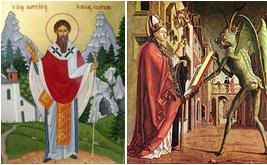 ST. WOLFGANG OF REGENSBURG (Germany, 924-994)
ST. WOLFGANG OF REGENSBURG (Germany, 924-994)
Benedictine, Reformer, Missionary, Bishop, Hermit
Descended from Swabian princes. Ordained a Benedictine
monk at age 42 after being a reform-minded Church
school teacher in Trier. Loyal to Emperor Otto the Great,
took part in several imperial Diets, and was sent
as a missionary to Hungary before being named Bishop of
Regensburg. Continued his passion for clerical reform,
starting with St. Emmeram's Abbey. Also became tutor
to Emperor Henry II, who would become a saint himself.
Ended his days as a hermit.
OR today.
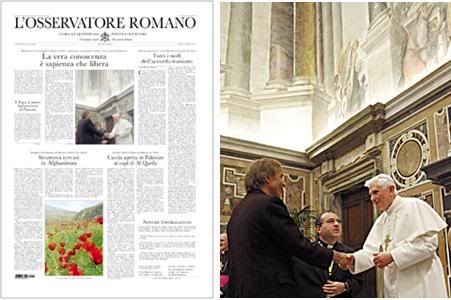
Speaking to scientists convened for the International Year for Astronomy,
Benedict XVI encourages the dialog between faith and reason:
'True knowledge is wisdom that liberates'
Other Page 1 stories: The Pope receives the new ambassador from Panama; stumbling blocks
in getting Iran to a meaningful accord over its nuclear program; UN refuses to consider its own
security measures for Afghanistan; and Pakistan pursues hunt for Al Qaeda leaders within
its borders.
THE POPE'S DAY
The Holy Father met today with
- H.E. Nikola Ivanov Kaludov, Ambassador from Bulgaria, who presented his credentials, Address in French.
- Cardinal Giovanni Battista Re, Prefect of the Congregation for Bishops (weekly meeting)
- Cardinal Agostino Vallini, Vicar general of His Holiness in the Diocese of Rome
- HRH the Prince of Hohenzollern and family.
The Vatican also issued a clarification on the issue of priestly celibacy in the forthcoming
Apostolic Constitution for converting Anglicans. Story below.
[Modificato da TERESA BENEDETTA 01/11/2009 03:01] |
| |
 31/10/2009 15:33 31/10/2009 15:33 |
|
| | | OFFLINE | | Post: 18.767
Post: 1.415 | Registrato il: 28/08/2005
Registrato il: 20/01/2009 | Administratore | Utente Veteran | |
|

 CLARIFICATION FROM THE VATICAN
CLARIFICATION FROM THE VATICAN
by Fr. Federico Lombardi, S.J.

October 31, 2009
ON SPECULATIONS ABOUT THE CELIBACY ISSUE
IN THE ANNOUNCED APOSTOLIC CONSTITUTION
REGARDING PERSONAL ORDINARIATES FOR ANGLICANS
ENTERING INTO FULL COMMUNION WITH THE CATHOLIC CHURCH
There has been widespread speculation, based on supposedly knowledgeable remarks by an Italian correspondent Andrea Tornielli, that the delay in publication of the Apostolic Constitution regarding Personal Ordinariates for Anglicans entering into full communion with the Catholic Church, announced on October 20, 2009, by Cardinal William Levada, Prefect of the Congregation for the Doctrine of the Faith, is due to more than "technical" reasons.
According to this speculation, there is a serious substantial issue at the basis of the delay, namely, disagreement about whether celibacy will be the norm for the future clergy of the Provision.
Cardinal Levada offered the following comments on this speculation:
Had I been asked I would happily have clarified any doubt about my remarks at the press conference. There is no substance to such speculation. No one at the Vatican has mentioned any such issue to me.
The delay is purely technical in the sense of ensuring consistency in canonical language and references. The translation issues are secondary; the decision not to delay publication in order to wait for the ‘official’ Latin text to be published in Acta Apostolicae Sedis was made some time ago.
The drafts prepared by the working group, and submitted for study and approval through the usual process followed by the Congregation, have all included the following statement, currently Article VI of the Constitution:
§1 Those who ministered as Anglican deacons, priests, or bishops, and who fulfill the requisites established by canon law and are not impeded by irregularities or other impediments may be accepted by the Ordinary as candidates for Holy Orders in the Catholic Church.
In the case of married ministers, the norms established in the Encyclical Letter of Pope Paul VI Sacerdotalis coelibatus, n. 42 and in the Statement "In June" are to be observed. Unmarried ministers must submit to the norm of clerical celibacy of CIC can. 277, §1.
§2. The Ordinary, in full observance of the discipline of celibate clergy in the Latin Church, as a rule (pro regula) will admit only celibate men to the order of presbyter. He may also petition the Roman Pontiff, as a derogation from can. 277, §1, for the admission of married men to the order of presbyter on a case by case basis, according to objective criteria approved by the Holy See.
This article is to be understood as consistent with the current practice of the Church, in which married former Anglican ministers may be admitted to priestly ministry in the Catholic Church on a case by case basis.
With regard to future seminarians, it was considered purely speculative whether there might be some cases in which a dispensation from the celibacy rule might be petitioned. For this reason, objective criteria about any such possibilities (e.g. married seminarians already in preparation) are to be developed jointly by the Personal Ordinariate and the Episcopal Conference, and submitted for approval of the Holy See."
Cardinal Levada said he anticipates the technical work on the Constitution and Norms will be completed by the end of the first week of November.
Goes to show what a pointless exercise it is, even by someone like Andrea Tornielli, to speculate over sensitive provisions of an official document - particularly one without precedent - that has not been released. Which is why, as much as I admire Mr. Tornielli, I did not have the least temptation to pass on his speculation in the Forum.
[Modificato da TERESA BENEDETTA 31/10/2009 15:42] |
| |
 31/10/2009 17:43 31/10/2009 17:43 |
|
| | | OFFLINE | | Post: 18.768
Post: 1.416 | Registrato il: 28/08/2005
Registrato il: 20/01/2009 | Administratore | Utente Veteran | |
|

 Papal initiative was not about
Papal initiative was not about
imposing dominion on Anglicans
and will not hurt ecumenism,
says prominent Anglican theologian
Interview by Salvatore Mazza
Translated from

October 30, 2009
LONDON - Benedict XVI's initiative to accommodate Anglicans who may wish to rejoin the Church of Rome demonstrates 'imagination not opportunism', says John Milbank, a noted theologian not just in the Anglican world but in all of the non-Catholic Christian confessions.
"I believe the Pope has wider aims in mind than just bringing back a number of Anglicans under his 'dominion'."
Professor of religion, politics and ethics at the University of Nottingham, Milbank was quoted soon after the election of Benedict XVI to have exclaimed, "I hope that under this Pope, the unity of Christians will be re-established".
"I am not sure if I said it that way," he clarifies, "but very likely, I said that with this Pope, Christians can begin finding their unity again. I believe this because his theology, which develops new theology in the integration of reason and faith, is greatly fascinating for Orthodox and Anglican tradition."
What do you think of this (latest) initiative by Benedict XVI?
I think it is remarkable. In the first place, because it acknowledges a certain value and validity in the Anglican tradition.
And consequently, it shows an acknowledgment that Catholicism can be expressed validly in cultural diversity.
Third, because it creates a specific circumstance which allows married priests, a practice which lives on in the Greek Orthodox tradition from their past.
And finally, because it shows the Pope correctly believes that there is a new potential today to reunite Christians under the Pontiff's authority.
So you do not consider it an 'aggressive' action...
No, certainly not. Rather I think it is a 'creative' act, even if I am sorry for the embarrassment it caused the Archbishop of Canterbury, who nevertheless has responded positively, since he is able to see that in the long run, this is good for all Christians.
Is it possible, as some speculate, that there will be a 'hemorrhaging' of Anglicans?
That's difficult to know. It could have such an effect in North America. But in Great Britain, Anglicanism is so closely linked to institutions and parishes that if only for legal reasons, it will not be easy to transfer them to the jurisdiction of the Catholic Church.
And many will continue to be reluctant to leave a parochial system much more rooted in day to day life compared to the British Catholic parishes.
Do you think this development could help the Anglican Communion in the difficult time it is undergoing?
Of course, it will help many persons singularly. Beyond that, I think ti will contribute to create a new space of 'fluidity' between Anglicanism adn Catholicism.
It is possible that a great part of the Anglicans who are closest to Catholicism will leave, which would then orient the Anglican Communion much more towards Protestantism than it already is.
But I don't think this will happen right away, for the reasons I have mentioned, and also because many Anglicans who feel close to Catholicism, including Rowan Williams himself, now accept the ordination of women.
Italians would be very surprised to know how many Anglicans - again, with Williams among them - agree with the Pope on practically every theological and ecclesiological issue, including the Catholic stand on sexuality and the concept of gender, even if they believe that women should be allowed to become priests. And I am one of them.
Can the ecumenical dialog draw any benefit from this situation?
I think so, precisely because of that new 'fluidity'. The
uniate Anglicans' - let us call them that for convenience - can be a bridge between Anglicans and Catholics.
But I also think that one of the consequences of this situation risks raising a paradox, because in the long term, it may encourage more discussion about women priests in the Catholic Church.
For example, I have been impressed by how some very young Catholics who consider themselves conservative have not minded receiving Communion from Anglican women priests. [But that does not have any sacramental validity for Catholics, does it? I'd say these young Catholics perhaps need better catechesis.]
But making forecasts is never easy. For now, let us simply welcome this move by the Pope who is demonstrating imagination, not opportunism. This unilateral act has truly opened a new space for inter-confessional communication.
|
| |
 31/10/2009 19:18 31/10/2009 19:18 |
|
| | | OFFLINE | | Post: 18.769
Post: 1.417 | Registrato il: 28/08/2005
Registrato il: 20/01/2009 | Administratore | Utente Veteran | |
|
 i601.photobucket.com/albums/tt96/MARITER_7/BANNERS-LOGOS/B16-SP-LITRE...
Thanks to NLM for this, which notes that a shorter version of the article appears in the Oct. 29 issue of The Catholic Herald.
The Compendium Eucharisticum:
i601.photobucket.com/albums/tt96/MARITER_7/BANNERS-LOGOS/B16-SP-LITRE...
Thanks to NLM for this, which notes that a shorter version of the article appears in the Oct. 29 issue of The Catholic Herald.
The Compendium Eucharisticum:
The first time Benedict XVI's liturgical vision
ins concretised in an official Vatican publication
by Dr Alcuin Reid

Oct. 30, 2009
A small but significant step in the ongoing liturgical reform of Pope Benedict XVI took place a little over a week ago when the Latin edition of the Compendium Eucharisticum, proposed by the 2005 Synod of Bishops and announced by Pope Benedict XVI in 2007, was published by the Vatican.
The Holy Father called for a volume that would “help make the memorial of the Passover of the Lord increasingly the source and summit of the Church's life and mission...to encourage each member of the faithful to make his or her life a true act of spiritual worship.”
It was to contain “useful aids for a correct understanding, celebration and adoration of the Sacrament of the Altar.”
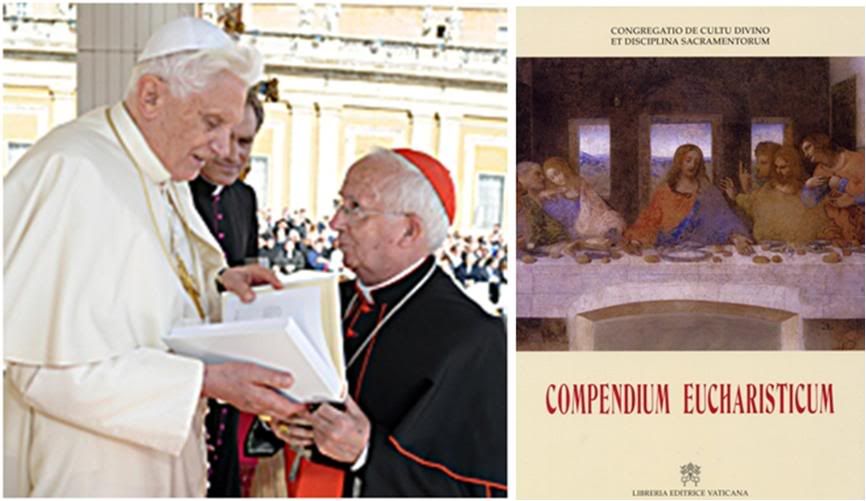
And that is precisely what Antonio Cardinal Cañizares Llovera, Prefect of the Congregation for Divine Worship and the Sacraments, presented to Pope Benedict on October 21st.
In publishing the Compendium Pope Benedict is, in a way, acting as the “head of a household, who brings out of his treasure things new and old.” For it includes liturgical, doctrinal and devotional texts from throughout the Church’s history, placing the celebration of the Eucharist within the framework of dogma and clearly indicating the role and value of devotional practices related to the Blessed Eucharist.
Doctrinally, the Council of Trent, Vatican II, John Paul II and the Compendium of the Catechism of the Catholic Church are cited, presenting an unambiguous précis of the Church’s belief in the Real Presence, the sacrificial nature of the Mass and the place of the liturgical celebration of the Eucharist in the life of the Church.
Liturgically, the complete Order of Mass is given for both the modern and more ancient uses of the Mass (old and new rites). So too is the whole text of the Divine Office for the Solemnity of Corpus Christi ― coming as it does from St Thomas Aquinas ― again, according to the breviaries published by both Paul VI and Blessed John XXIII. The rite of Benediction is included, as are several litanies and hymns.
Interestingly, the Congregation for Divine Worship has included the vesting prayers for priests and bishops, and the customary prayers of preparation for and thanksgiving after Mass.
There is also a notable recovery of a traditional visual language in the Compendium. The inclusion of Bout's “Last Supper”, Zurbaran’s “Agnus Dei”, Valasquez’ “Crucifixion”, Giotto’s “Lotio pedum”, Cavalieri’s “Corpus Chirsti” and Ysenbrandt’s “Missa S. Gregorii” underline the importance of beauty and the value of such cultural fruits of the Church’s faith in the Blessed Eucharist.
Taken as a whole the Compendium is a timely vademecum, a handy tool, which will serve to nourish and enrich Catholic faith and practice. It is to be hoped that the envisaged translations into the major languages will appear promptly.
But the significance of this publication lies in the fact that this is the first time that the liturgical vision of Pope Benedict XVI has been concretised in an official publication of the Holy See.
In presenting such riches from the Church’s wider liturgical, doctrinal and artistic tradition pertaining to the Blessed Eucharist, and thereby recovering some elements sidelined in recent decades, the Compendium places the newer liturgical forms firmly within the continuity of that tradition.
It thus serves to facilitate that mutual enrichment of which the Pope has spoken, in accordance with his wish that the sacred liturgy ― most especially the Sacrament that is its centre ― be celebrated worthily, and that the riches which have developed in the Church’s tradition take their proper place in the Church of the twenty-first century.
As mentioned in the first story about the Compendium Eucharisticum two weeks ago, its publication follows a specific provision in Benedict XVI's 2007 post-Synodal Apostolic Exhortation on the Eucharist, Sacramentum caritatis. For now, the Compendium is only available in Latin, but LEV says the translations in teh Vatican official languages will follow soon.
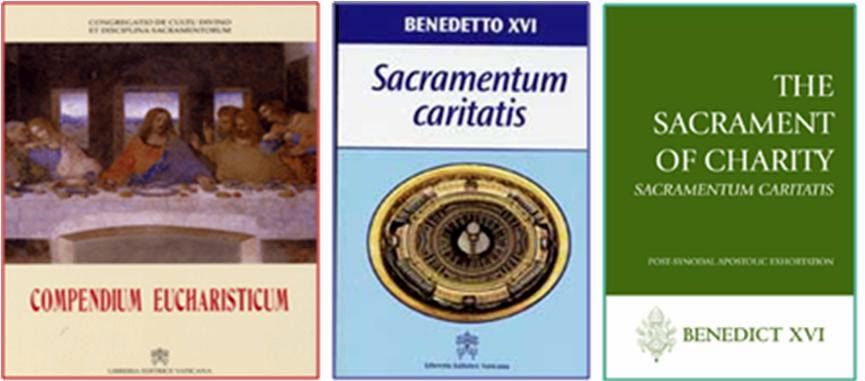
[Modificato da TERESA BENEDETTA 08/01/2010 22:29] |
| |
 01/11/2009 02:50 01/11/2009 02:50 |
|
| | | OFFLINE | | Post: 18.773
Post: 1.421 | Registrato il: 28/08/2005
Registrato il: 20/01/2009 | Administratore | Utente Veteran | |
|
 Pope tells new ambassador
Pope tells new ambassador
Bulgaria has a vital role
in the construction of Europe

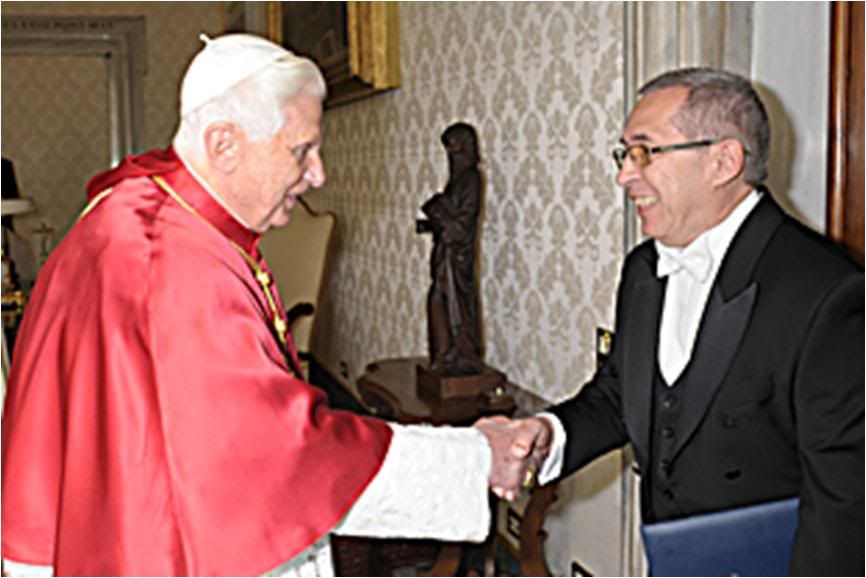
Oct. 31, 2009 (RV) - Pope Benedict XVI reflected on the aftermath of the fall of the Berlin wall as he received the new Bulgarian Ambassador to the Holy See.
Nikola Ivanov KALUDOV, a graduate of the Moscow Diplomatic Academy, was welcomed by the Pope to the Vatican Saturday. No stranger to the eternal city, Ambassador Kaludov’s last posting was to the Italian Republic.
In his message written in French, the Pope recalls John Paul II’s 2002 apostolic visit to Bulgaria which he said gave birth to a new phase in diplomatic relations between the two states.
Pope Benedict notes that this autumn we celebrate the twentieth anniversary of the fall of the Berlin Wall which he says has enabled Bulgaria to choose democracy and return to free and independent relations with the entire European continent.
Located in the heart of the Balkans, Bulgaria is one of the oldest states in Europe, founded in 681. The Pope acknowledged the eastern European nation’s aspirations for increased integration within European Union of which it is a member state since 1 January 2007.
The Pope pointed out that in this process of European construction it is important that individual nations do not sacrifice their own cultural identity, but instead find ways to make it bear good fruit that will enrich the whole community.
Some 85% of the Bulgarian population are Orthodox Christians and 13% Muslims. Around 10% of the population are of Turkish origin while 3% are Roma.
Pope Benedict noted that precisely because of its geographical and cultural situation, Bulgaria has undoubtedly an important role in building peaceful relations between countries which surround it, and in the defence and promotion of human rights.
This concern for the common good of peoples can not be confined to the borders of the continent,- continues the Pope - it is also necessary to pay attention to creating conditions for successful globalization. If it is to be experienced positively it must , indeed serve "the whole man and all men."
In this sense, an authentic development of man and society must include a spiritual dimension.
"The Christian culture that permeates deeply your people is not only a treasure of the past to preserve, but also a guarantee of a really promising future," He said.
The invoking the intercession of the Virgin Mary and the Apostles of the East Saints Cyril and Methodius, sent his blessings and greetings to the Bulgarian people and its leaders.
 Here is a translation of the Holy Father's words to the ambassador, delivered in French:
Here is a translation of the Holy Father's words to the ambassador, delivered in French:
Mr. Ambassador,
I am happy to welcome Your Excellency on this solemn occasion of the presentation of the letters accrediting you as Ambassador extraordinary and plenipotentiary of the Republic of Bulgaria to the Holy See.
I thank you, Mr. Ambassador, for the kind words that you addressed to me. In return, I would be grateful if you would express my cordial wishes to the President of the Republic, Georgi Parvanov, for himself, as well as for the happiness and success of the Bulgarian people.
For my part, I am happy over the good relations between Bulgaria and the Holy See, within the dynamic created by the trip of my predecessor Pope John Paul II to your country in 2002. These relations must be intensified, and I was glad to hear your desire to work ardently to reinforce them and to widen their scope.
This fall, we will celebrate the 20th anniversary of the fall of the Berlin Wall which allowed Bulgaria to make the choice for democracy and recovering free and autonomous relations with the rest of the European continent.
I know that your country today is making important efforts towards even stronger integration into the European Union of which it has been a part since January 1, 2007. It is important that in the process of European construction, each people does not sacrifice its own cultural identity, but rather find the means to make it bear good fruit to enrich the entire community.
Because of its geographical and cultural situation, it is particularly fortunate, as you said, that your nation is not only concerned about its own destiny, but that it pays great attention to the countries next to it and is working to promote their relations with the European Union.
Bulgaria undoubtedly has an important role to play in the construction of peaceable relations with the nations which surround it, as well as in the defense and promotion of human rights.
As you have also underscored just now, this concern for the common good of peoples cannot be limited to the frontiers of the Continent. It is also necessary to create the conditions for successful globalization.
In order that this may be lived positively, it must be able to serve all of man and all men. It is this principle that I wished to underscore forcefully in my recent encyclical Caritas in veritate.
Indeed, it is essential that legitimately sought development does not concern only the economic domain, but take into account the integralness of the human being. The measure of man does not reside in what he possesses, but in the blossoming of his being according to all the potentialities hidden in his nature.
This principle finds its ultimate reason in God's love as the Creator, which is fully revealed by the divine Word. In this sense, in order that the development of man and society may be authentic, it must necesasrily involve a spiritual dimension (Nos. 76-77).
It also requires on the part of all piblic authorities a great moral demand on themselves so that they may manage the authority entrusted to them in an effective and disinterested manner.
The Christian culture which profoundly impregnates your people is not just a treasure of the past to be conserved, but also the earnest for a truly promising future in which it will protect men from the temptations that always threaten to make him forget his own greatness as well as the unity of the human species and the exigencies of solidarity that it implies.
Inspired by this intention, the Catholic community in Bulgaria wishes to work for the success of the whole population. This shared concern for the common good constitutes one of the elements which should facilitate the dialog among the many different religious communities which compose the cultural landscape of your ancient nation.
This dialog, in order to be sincere and constructive, requires reciprocal knowledge and esteem that the public authorities could greatly facilitate by the consideration that they themselves have for the different spiritual families.
For its part, the Catholic community expresses its wish to be generously open to everyone and to work with everyone. She demonstrates this concretely through social work whose benefits she does not limit only to her members.
Through you, Mr. Ambasssador, I wish to extend my warm wishes to the bishops, priests, deacons and all the faithful who make up the Catholic community in your country. I call on them to consider the great riches that God, in the extent of his mercy, has placed in the hearts of believers, and for this reason, they can engage themselves with audacity, through a cooperation that is as close as possible with all citizens of good will, in order to prove in all aspects the dignity that God has inscribed within man's being.
As Your Excellency officially begins your functions at the Holy See, I wish you all the best for the happy achievement of your mission. You may be sure, Mr. Ambassador, that you will always find among my co-workers all the attention and cordial understanding that your high function requires, as well as the affection of the Successor of Peter for your country.
Invoking the intercession of the Virgin Mary and Saints Cyril and Methodius, I pray the Lord to bestow generous blessings on yourself, your family and your co-workers, as well as on the Bulgarian people and their leaders.
[Modificato da TERESA BENEDETTA 02/11/2009 04:26] |
| |
 01/11/2009 11:06 01/11/2009 11:06 |
|
| | | OFFLINE | | Post: 18.774
Post: 1.422 | Registrato il: 28/08/2005
Registrato il: 20/01/2009 | Administratore | Utente Veteran | |
|
 I translated this essay dutifully only because it is about CIV and was deemed worthy to be on the front page of the Nov. 1, 2009, issue of L'Osservatore Romano. But to a simple layman like me, it makes a rather banal, self-evident and circular argument - which it claims to be theological - about universal brotherhood that does not seem to offer any fresh insights into the encyclical, nor into the concept of brotherhood itself.
The encyclical of universal fraternity
I translated this essay dutifully only because it is about CIV and was deemed worthy to be on the front page of the Nov. 1, 2009, issue of L'Osservatore Romano. But to a simple layman like me, it makes a rather banal, self-evident and circular argument - which it claims to be theological - about universal brotherhood that does not seem to offer any fresh insights into the encyclical, nor into the concept of brotherhood itself.
The encyclical of universal fraternity
by Rosino Gibellini
Translated from
the 11/1/09 issue of
 Caritas in veritate
Caritas in veritate can be defined as the encyclical of universal fraternity because this is the central theological category in Benedict XVI's complex discourse on the social realty of our world in the throes of globalization.
The Pope applies the social doctrine of the Church in a particular way, expressed, precisely, in the category of universal fraternity.
It has been observed that John Paul II often spoke about sociality, a subject Benedict XVI takes back to its theological source, which is fraternity.
The third chapter of the encyclical (Nos. 34-42), is entitled 'Fraternity, economic development and civilian society' and may be considered the theological center of the encyclical.
The concept of fraternity is dear to Joseph Ratzinger's theology, and he had dedicated a course in Vienna to this subject in 1958, when the young theologian was just at the beginning of his professorship in the theological-philosophical seminary of Freising.
The lecture texts would be published in 1960 (when Joseph Ratzinger was already teaching at the University of Bonn) as Die Christliche Bruederlichkeit (Christian brotherhood) (Munich, 1960; new ed, Munich Kosel-Verlag, 2006; Italian translation, Rome 1962; new translation, Brescia, Queriniana, 2005).
[So many editions for an early book! And the Italian translation came out in 1962, very likely before he even attended the first session of Vatican-II in October 1962. But there was no particular reason they would have picked him out of the multitude so soon at the time - and the Italian publisher must be commended for his prescience. Then to come out in a new Italian translation the year of his election, before the German re-edition, even!]
Christian brotherhood, he explains in this text, is internal to the Church: it is 'the reciprocal fraternity of Christians' who invoke God, trustingly, as 'Abba' (Our Father), as Jesus taught us.
And it is an open fraternity because the Church - Ratzinger cites Von Balthasar - 'is an open space and a dynamic concept'. In fact, it is "the movement of the Kingdom of God penetrating the world, in the sense of eschatological totality". (La fraternita cristiana, p. 100).
This fraternity also has its frontiers - it sees a duality between Church and non-Church. But "the fraternal Christian community is not against everyone - on the contrary!" and "it is clear that the work of Jesus is not aimed only at part, but at everyone, at the unity of mankind" (ivi, p.94).
Christian fraternity cannot be reduced to philanthropy, it is not assimilable to stoic cosmopolitanism or the Enlightenment kind, but it is an expression of 'true universalism' because it is placed "at the service of everyone" through agape ('love') and diakonia (service).
In this text, the difference between universal brotherhood in the Enlightenment and in Christianity is well evidenced. It is true that the Enlightenment amplified the concept of 'brother', speaking of universal brotherhood on the basis of common human nature.
But a brotherhood that extensive can become an unrealistic and vague expression of humanitarianism, as in the words of Schiller's great Hymn to Joy: "Embrace each other, millions!"
Christian fraternity, instead, opens up persons to each other and becomes universal brotherhood in agape and diakonia, love and service, thus bringing down barriers in the concreteness of life situations. This is the theme advocated in the encyclical.
Caritas in veritate in fact affirms that true brotherhood, operating beyond every barrier and frontier, is born from giving, whose logic is introduces into the economic,social and political fabric:
The human community that we build by ourselves can never, purely by its own strength, be a fully fraternal community, nor can it overcome every division and become a truly universal community.
The unity of the human race, a fraternal communion transcending every barrier, is called into being by the word of God-who-is-Love.
In addressing this key question, we must make it clear, on the one hand, that the logic of gift does not exclude justice, nor does it merely sit alongside it as a second element added from without; on the other hand, economic, social and political development, if it is to be authentically human, needs to make room for the principle of gratuitousness as an expression of fraternity.
According to the Pope, in this time of globalization that mankind has entered, and in which it becomes 'ever more inter-connected' (No. 42), human beings as individuals and as communities need a fundamental ethical criterion.
This criterion is a theological category, universal brotherhood, which makes us consider ourselves members of the same 'human family'. [How is this different, as a definition, from the Enlightenment idea of universal brotherhood on the basis of one common human nature?]
If one were to cite just one statement from the encyclical, to get to the center of the vision it proposes, one could choose this:
Globalization is a multifaceted and complex phenomenon which must be grasped in the diversity and unity of all its different dimensions, including the theological dimension. In this way it will be possible to experience and to steer the globalization of humanity in relational terms, in terms of communion and the sharing of goods.
This is the most strictly theological part, in which the concrete indications for the social and economic contents of the encyclical that propose the vision of universal brotherhood constitute the key to reading it and the logical consequence of 'rationality' and 'sharing' as fundamental criteria and as 'theological' orientation.
In order to be "able to generate a new vision and muster new energy in the service of a truly integral humanism" (No.78).
As the OR does not qualify the author with a single line of biodata, I Googled him, but although I can find no biodata in Italian or in English, it appears Mr. Gibellini - described as a theologian, but a lay one, it appears - is the author of several books on theology, including a Panorama of the Theology of the 20th Century and one on Liberation Theology.
This would explain why he is able to cite one of Joseph Ratzinger's early and rarely cited books, and provide us with a neat little biographical tidbit to add to what we know.
Gibellini is also the current editor of the Italian edition of Concilium, the post-Vatican II magazine that Hans Urs Von Balthasar, Yves Cognar and Joseph Ratzinger abandoned for being too progressive to found Communio.
It makes me think the OR published the essay because of who the author is, not because of its intrinsic value.
[Modificato da TERESA BENEDETTA 01/11/2009 11:13] |
| |
 01/11/2009 14:22 01/11/2009 14:22 |
|
| | | OFFLINE | | Post: 18.775
Post: 1.423 | Registrato il: 28/08/2005
Registrato il: 20/01/2009 | Administratore | Utente Veteran | |
|
 Sunday, Nov. 1
Sunday, Nov. 1
ALL SAINTS DAY
 Fra Angelico, Fiesole San Domenico altarpiece, 1423-24, National Gallery of London. From left, Virgin Mary with Apostles and Other Saints, Christ Glorious in the Court of Heaven, Forerunners of Christ.
Fra Angelico, Fiesole San Domenico altarpiece, 1423-24, National Gallery of London. From left, Virgin Mary with Apostles and Other Saints, Christ Glorious in the Court of Heaven, Forerunners of Christ.
 From left, Raphael, Triumph of Religion, Fresco, 1508-1511, Vatican Apostolic Palace; Jan and Hubert Van Eyck, Ghent altarpiece, 1432; Vassily Kandinsky, All Saints, 1911.
From left, Raphael, Triumph of Religion, Fresco, 1508-1511, Vatican Apostolic Palace; Jan and Hubert Van Eyck, Ghent altarpiece, 1432; Vassily Kandinsky, All Saints, 1911.
OR today.
 The only papal news in this issue is the Holy Father's audience with the new ambassador from Bulgaria. Other Page 1
The only papal news in this issue is the Holy Father's audience with the new ambassador from Bulgaria. Other Page 1
stories: An essay on Caritas in veritate as the encyclical of universal brotherhood (translated in post above);
Tehran's new delaying tactic - asks for new negotiations over its nuclear program; and in Afghanistan, President
Karzai's rival decides to boycott the runoff election after Karzai denies to change composition of electoral
commission thought to be on his side.
THE POPE'S DAY
Sunday Angelus - Before the prayer, the Holy Father spoke about All Saints' Day today and
All Souls Day tomorrow, and after the prayer, he recalled the tenth anniversary of the historic
joint statement between the Catholic Church and the world Lutheran Federation on the concept
of justification.
THE POPE'S PRAYER INTENTIONS
FOR NOVEMBER 2009
General intention:
"That all the men and women in the world, especially those who have responsibilities in the field of politics and economics, may never fail in their commitment to safeguard creation".
Mission intention:
"That believers in the different religions, through the testimony of their lives and fraternal dialogue, may clearly demonstrate that the name of God is a bearer of peace".
[Modificato da TERESA BENEDETTA 01/11/2009 17:26] |
| |
 01/11/2009 14:51 01/11/2009 14:51 |
|
| | | OFFLINE | | Post: 18.776
Post: 1.424 | Registrato il: 28/08/2005
Registrato il: 20/01/2009 | Administratore | Utente Veteran | |
|

 Pope's coming visit to the Shroud of Turin
Pope's coming visit to the Shroud of Turin
prompts the question 'Is it real?'

Nov 1, 2009
Las Vegas NV (PRWEB)- Pope Benedict XVI will visit the Shroud of Turin on the 2nd of May, 2010, which prompts the question "Is the Holy Shroud of Turin real?" According to Researcher Dr. Peter J. Shield, "The amassed evidence for its authenticity is indisputable!"
The Pope will visit the Shroud on its public viewing just ten years after its Exposition in the jubilee year 2000. The Shroud will be on display in the Cathedral of Turin from April 10 to May 23.
Dr. Shield, whose radio and relevision broadcasts of the "World of Unexplained Mysteries" has featured the Shroud as the world's greatest unexplained mystery, has been involved in reporting on the evidence for the authenticity of the Shroud of Turin for over 20 years.
It is his considered opinion that the Shroud is the real article.
Dr. Shield arrived at this conclusion after an interview with Dr. Alan Adler who did the original blood analysis on the Shroud.
"The amassed evidence for its authenticity is indisputable! I recorded this interview prior to Alan's unexpected death in 2000. In 2010, and for the first time, it will be possible to see the Holy Shroud following the intervention it underwent in 2002: a conservation and restoration operation during which pieces of cloth that had been burned in the Chambery fire of 1532, and the various 'patches' applied by the Poor Clares, were removed, together with the Holland cloth to which the Shroud had been fastened in 1534, with the Holy Linen now placed on a new support."
Shield provides the following facts about the Shroud:
The Man on the Shroud
He was naked.
He was 6 ft. tall.
He wore a beard and shoulder length hair.
He had an enlarged chest from trying to breath.
He had been beaten with a Roman Flagrum.
He had puncture marks on his skull.
He had bled whilst upright on the cross.
He had suffered most of his wounds whilst alive.
Wound on his side with no swelling indicates that the wound happened after he had died.
Other signs and clues - Dirt on his knees and the tip of his nose is reported to contain minerals found in the Palestine region!
Blood smears from the upper shoulder part of the shroud are thought to be microscopic Oak wood remains!
Pollen has been found on the shroud's surface from plants found only in Jerusalem.
The recent announcement that an Italian scientist has duplicated the image on the Shroud proves nothing. Replicas of the shroud have been produced since the 1300s and one of these was discovered by Dr. Shield on a recent visit to the remote Island of Malta, and is the bases of his Historic Fiction "In the Image of his God - the curse of the Shroud" which was launched at the International Convention of the Shroud at Ohio State University last year.
BRIEF HISTORY RELATED TO THE SHROUD
• According to the Catholic Church's calculations the resurrection took place on Sunday morning April 9th AD 30.
• AD 30 - Edessa, 400 miles from Jerusalem, King Abgar receives cloth with image of a man believed to be Jesus (Painting at St. Catherine's, Sinai)
• AD 222-230 Mandylion of Edessa [the relic known as Veronica's Veil which is now kept at the Vatican]
• AD 550 Pantocrator Image (St. Catherine's)
• AD 944 Mandylion moved to Constantinople.
• AD 1204-1307 Knights Templar believed to have come across the Shroud.
• AD 1578 - The Shroud reaches Turin.
 |
| |
 01/11/2009 15:15 01/11/2009 15:15 |
|
| | | OFFLINE | | Post: 18.777
Post: 1.425 | Registrato il: 28/08/2005
Registrato il: 20/01/2009 | Administratore | Utente Veteran | |
|
 ANGELUS TODAY
ANGELUS TODAY
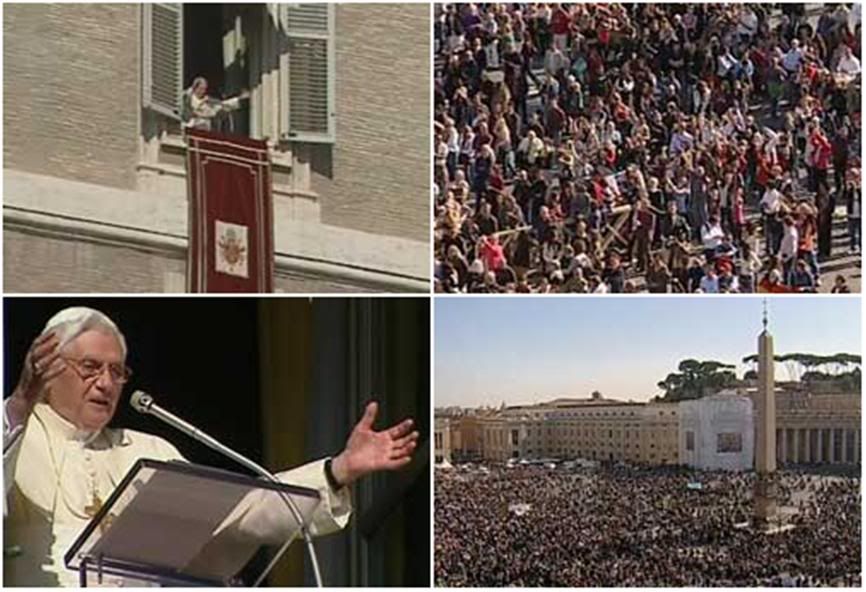
In his Angelus mini-homily today, the Holy Father spoke on the significance of All Saints Day today and All Souls Day tomorrow.
After the prayer, he recalled that it is the tenth anniversary of the historic joint statement between the Catholic Church and the World Lutheran Federation on the concept of justification, agreeing, in effect, that they should respect each other's interpretation of justification. John Paul II described this - the result of extensive theological dialog - as a milestone in ecumenism.
Here is what he said in English today:
I greet all the English-speaking pilgrims and visitors present for this Angelus. Today we celebrate the great solemnity of All Saints.
In honouring all of the holy men and women gone before us marked with the sign of faith, and who are now united with the Lord in Heaven, we are encouraged to pray and work with pure hearts as we anticipate with joy seeing the Lord as he really is.
Upon each of you and your loved ones at home, I invoke God’s abundant blessings!
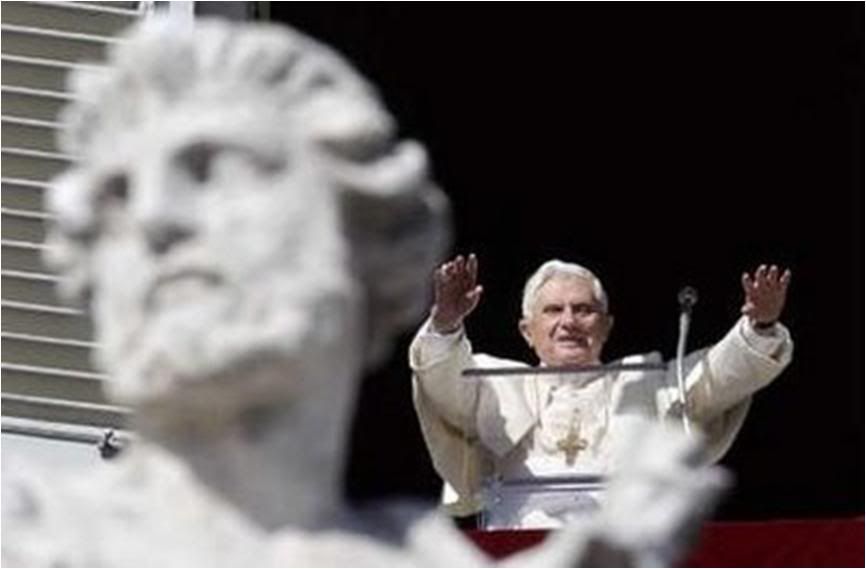
Here is a translation of the Holy Father's words:
Dear brothers and sisters!
This Sunday coincides with the Solemnity of All Saints, which invites the pilgrim Church on earth to a foretaste of the eternal feast in the heavenly community, and to revive our hope in eternal life.
It is 14 centuries this year since the Pantheon - one of the oldest and most celebrated Roman monuments - was dedicated to Christian worship and named for the Virgin Mary and all the Martyrs - Sancta Maria ad Martyres.
The temple of all the pagan divinities was thus converted to the memory of all those who, as the Book of Apocalypse says, "have survived the time of great distress (and) washed their robes and made them white in the blood of the Lamb" (Rev 7,14).
Subsequently, the celebration of all the martyrs was extended to all the saints, "a great multitude, which no one could count, from every nation, race, people, and tongue" (Rev 7,9) - as St. John says.
In this Year for Priests, I am happy to remember with special veneration all the priest saints - those whom the Church has canonized and offered as examples of spiritual and pastoral virtues, and those much more numerous who are known only to the Lord.
Each of us keeps a grateful memory of some of them who have helped us to grow in faith and made us feel the goodness and closeness of God.
Then, tomorrow, is the annual commemoration of all the faithful departed. I wish to invite you to live this occasion according to authentic Christian spirit, that is, in the light that comes from the Paschal mystery.
Christ died and rose again, and opened for us the way to the house of the Father, the Kingdom of life and peace. Whoever follows Jesus in this life is welcome where he preceded us.
Therefore, as we visit the cemeteries, let us remember that resting in those tombs are merely the mortal remains of our dear ones who await the final resurrection.
Their souls, as Scripture tells us, are already 'in the hands of God" (Wis 3,1). Thus, the most proper and effective way to honor them is to pray for them, offering acts of faith, hope and charity.
In union with the Eucharistic Sacrifice, we can intercede for their eternal salvation, and experience the most profound communion in the expectation of finding ourselves together in enjoying forever the Love which created and redeemed us.
Dear friends, how beautiful and comforting is the communion of saints! It is a reality that instills a different dimension into our whole life. We are never alone! We are part of a spiritual 'company' where profound solidarity reigns: the good of each one is for the benefit of everyone, and vice-versa, common happiness irradiates every individual.
It is a mystery which, in some measure, we can already experience in this world, in the family, in friendship, and especially in the spiritual community of the Church.
May the Most Blessed Mary help us to walk expeditiously on the way of holiness, and may she be the Mother of mercy for the souls of the departed.
After the Angelus prayers, he had a special message that shows yet another aspect of the multi-track ecumenical dialog:
Exactly ten years have passed since ranking representatives of the World Lutheran Federation and the Catholic Church, on October 31, 1999, in Augsburg, signed the Joint Declaration on the Doctrine of Justification. That statement was adhered to in 2006 even by the World Methodist Council.
The document attested to a consensus among Lutherans and Catholics on the fundamental truths of the doctrine of justification - truths which lead us to the heart of the Gospel itself and to the essential questions of our life.
We are accepted and redeemed by God; our existence is inscribed in the horizon of grace; it is guided by a merciful God, who pardons our sins and calls us to a new life in the footsteps of his Son; we live in the grace of God and we are called to respond to his gift; all this liberates us from fear and instills hope and courage in a world full of uncertainties, uneasiness, and suffering.
On the day that the Joint Declaration was signed, the Servant of God John Paul II defined it as 'a milestone on the not easy way of reconstituting full unity among Christians" (Angelus, October 31, 1999).
This anniversary is thus an occasion to remember the truth about the justification of man, to which we bear common witness, reuniting us in ecumenical celebration that we may look more deeply into this doctribe and others that are the object of the ecumenical dialog.
I hope from my heart that this important anniversary may contribute to further progress in our journey towards the full and visible unity of all the disciples of Christ.
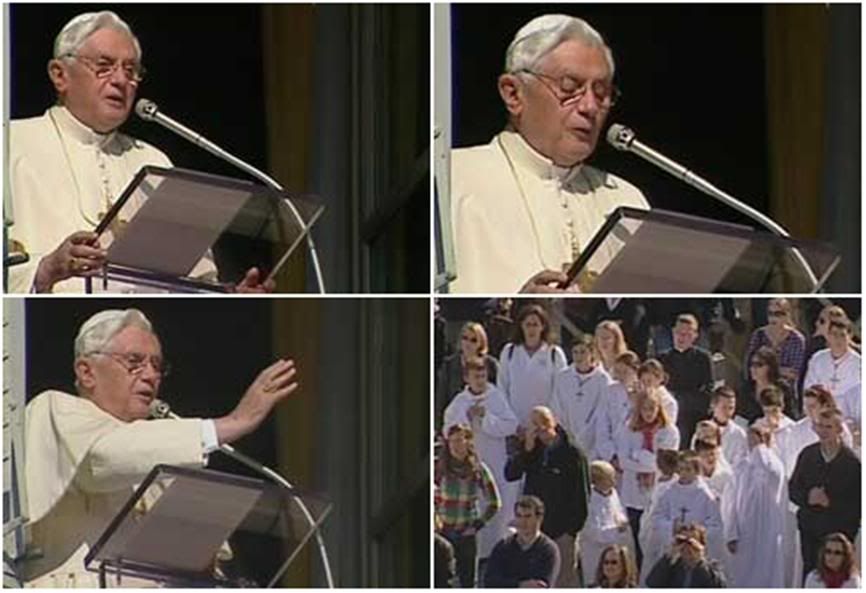

[Modificato da TERESA BENEDETTA 01/11/2009 17:20] |
| |
 02/11/2009 01:23 02/11/2009 01:23 |
|
| | | OFFLINE | | Post: 18.780
Post: 1.428 | Registrato il: 28/08/2005
Registrato il: 20/01/2009 | Administratore | Utente Veteran | |
|

 The document was signed for the Catholic Church by Cardinal Edward Cassidy, then the President of the Pontifical Council for Promoting Christian Unity, and by Cardinal Walter Kasper, who was the Council Secretary.
Cardinal Ratzinger and the historic
The document was signed for the Catholic Church by Cardinal Edward Cassidy, then the President of the Pontifical Council for Promoting Christian Unity, and by Cardinal Walter Kasper, who was the Council Secretary.
Cardinal Ratzinger and the historic
agreement on 'justification'
The Holy Father's message at the Angelus today about the tenth anniversary of the Joint Declaration on Justification with the World Lutheran Federation is a timely reminder that the ecumenical effort is taking place on another front - besides the Lefebvrians (within the Church), the Orthodox and the Anglicans, which have been very much in the news today.
The full text of the Joint Declaration on the Doctrine of Justification (JDDJ) is a 16-page document and may be found on
www.vatican.va/roman_curia/pontifical_councils/chrstuni/documents/rc_pc_chrstuni_doc_31101999_cath-luth-joint-declaration...
The JDDJ asserts that the past condemnations issued by both churches do not apply to their teaching as set forth in that document. The JDDJ specifically considers the notion of salvation itself: We are saved by God's grace through faith alone rather than by our own efforts. At the same time, the question arises about the spiritual significance of our "good works."
The Common statement in June 1999 that preceded the October 31, 1999, signing says:
On the basis of the agreements reached in the Joint Declaration on the Doctrine of Justification (JD), the Lutheran World Federation and the Catholic Church declare together:
"The understanding of the doctrine of justification set forth in this Declaration shows that a consensus in basic truths of the doctrine of justification exists between Lutherans and Catholics“ (JD 40).
On the basis of this consensus the Lutheran World Federation and the Catholic Church declare together: “The teaching of the Lutheran Churches presented in the Declaration does not fall under the condemnations from the Council of Trent. The condemnations in the Lutheran Confessions do not apply to the teaching of the Roman Catholic Church presented in this Declaration“ (JD 41).
Cardinal Joseph Ratzinger's crucial involvement in the JDDJ is recounted in two articles - one at the time of his election, and one contemporaneous with the JDDJ agreement:
Lutheran hailed Cardinal Ratzinger
as expert on Luther
ROME, MAY 5, 2005 (Zenit.org).- A leading Lutheran in Germany said in 1998 that Cardinal Joseph Ratzinger, now Benedict XVI, was one of the few who really understood Martin Luther.
The Protestant leader's statements were communicated to ZENIT by Sigrid Spath, a German Lutheran, who at times has been Cardinal Ratzinger's interpreter and who, for more than 30 years, has worked in the general curia of the Society of Jesus and collaborates with the Holy See.
Spath revealed details of the public meeting she witnessed between the then prefect of the Congregation for the Doctrine of the Faith, and Wolfgang Huber, former Lutheran Evangelical Bishop of Berlin and now president of the Council of the Evangelical Church in Germany.
During the debate on the encyclical Fides et Ratio, which took place in Rome in October 1998, Cardinal Ratzinger revealed that before entering university he had already read all of Luther's works written before the Reformation.
"That is, the reflections of Catholic Luther," Spath told ZENIT.
"Ratzinger invited those present to read those writings again, as they express the great battle that Luther had with himself to live and accept the teachings of the just and good God," she added. "'Dear Protestant friends, rediscover the Luther of those years,'" recommended Cardinal Ratzinger at the time.
"The debate lasted several hours," she recalled. "Bishop Huber was impressed by the intervention of the prefect of the Congregation for the Doctrine of the Faith and commented that Ratzinger is one of the few who really know Luther."
Cardinal Ratzinger's knowledge of Luther made possible the historic signing of the Joint Declaration on the Doctrine of Justification, approved by the Catholic Church and the World Lutheran Federation.
Some points of the proposal for the declaration presented in 1998 were rejected both by the Holy See as well as the federation.
When it seemed that the project would fail, the difficulties were surmounted by Bishop Johannes Hanselmann, former president of the World Lutheran Federation, and Cardinal Ratzinger, thanks to their long-standing friendship, which made possible a private meeting between them in November 1998.
After Dr. Hanselmann's death on Oct. 2, 1999, Cardinal Ratzinger revealed in a public address: "We had a very important meeting in my brother's house, in Germany, as it seemed that the consensus on the Doctrine of Justification had failed. In this way, in the course of a debate that lasted a whole day, we found the formulas that have clarified the points that still present difficulties. …
"With the formula elaborated in those days, both by the Lutheran Federation as well as the Catholic magisterium, they have been able to acknowledge that a consensus has been reached on some fundamental points of the Doctrine of Justification. It is not a global agreement, but with this formula it is possible to proceed to the signing of a document of consensus in the basic contents."
And the ever-diligent John Allen had a rather extensive report on Cardinal Ratzinger's role in all this back in September 1999:
Ratzinger credited
with saving Lutheran pact
By JOHN L. ALLEN JR.
More than 500 years ago, Martin Luther triggered the Protestant Reformation because he believed the Catholic church was fatally wrong about how salvation works. This fall, in Augsburg, Germany, Catholics and Lutherans will officially declare that argument resolved.
The two churches will abandon the anathemas they hurled at one another in the 1500s, in what is believed to be the first time the Vatican has ever nullified such a doctrinal excoriation. The signing will take place on Oct. 31, the anniversary of the day Luther nailed his 95 theses to the door of Wittenberg Cathedral.
It is a blockbuster agreement, a crowning achievement of the ecumenical dialogue spawned by Vatican II -- and it almost didn’t happen. Despite his public image as an ecumenical roadblock, the man credited by sources on both sides with saving it is none other than Cardinal Joseph Ratzinger, the head of the Vatican’s Congregation for the Doctrine of the Faith.
“It was Ratzinger who untied the knots,” said Bishop George Anderson, head of the Evangelical Lutheran Church of America, who spoke to NCR by telephone. “Without him we might not have an agreement.”
News of Ratzinger’s role is especially revealing since press reports identified him in June 1998, when the deal seemed in danger of unraveling, as the source of its problems.
Lutherans have traditionally held that salvation comes through faith alone, while Catholics emphasize good works. The heart of the new agreement, which combines both ideas, is this key sentence: “By grace alone, in faith in Christ’s saving work and not because of any merit on our part, we are accepted by God and receive the Holy Spirit, who renews our hearts while equipping us and calling us to good works.”
The agreement is expected to be especially welcome in Latin America and Eastern Europe, where competition for converts often strains the relationship between Lutherans and Catholics.
Experts also hope it will pave the way for further agreements toward “full communion” -- including the sharing of sacraments, worship and ministers.
Yet just a year ago, the deal seemed dead on arrival. Cardinal Edward Cassidy, head of the Pontifical Council for the Promotion of Christian Unity, stunned ecumenical enthusiasts in June 1998 by presenting an unexpected Catholic “response” to the Joint Declaration. This response was sharply critical, wondering aloud if the agreement really warranted reversing any anathemas.
Many Lutherans were furious; one claimed that the Holy See had “betrayed” both the Lutheran and the Roman Catholic theologians who had worked on the agreement, and that it would take decades to reestablish the trust that had been shattered.
Most Vatican observers believed the response flowed from Ratzinger’s pen.
Rumors of a rift between Cassidy and Ratzinger ensued, especially because that same summer Ratzinger had set back the dialogue with the Anglicans by suggesting the church’s teaching on the invalidity of Anglican ordinations was infallible.
German Lutherans were wary of Ratzinger, in part because in 1996 the German newsmagazine Focus reported that Ratzinger had vetoed a papal proposal to reverse the excommunication of Martin Luther. Vatican sources denied the report.
Those who know Ratzinger, however, say few figures have exercised greater influence on him than Luther. In a 1966 commentary on Vatican II’s “The Church in the Modern World,” Ratzinger said that the document leaned too heavily on Teilhard de Chardin and not enough on Luther - a remarkable comment in an era with no official Lutheran-Catholic contact, when many Catholics still branded Luther a heretic.
“Ratzinger has been involved in dialogue with Lutherans from way back,” said Br. Jeffrey Gros, ecumenical affairs specialist for the U.S. bishops. “In the 1980s he was even interested in declaring the Augsburg Confession [the first Lutheran declaration of faith] a Catholic document. To think that he wanted to torpedo this [agreement] is a total misread.”
On July 14, 1998, Ratzinger fired off a letter to the German newspaper Frankfurter Allgemeine calling such reports a “smooth lie.” Protesting that he had sought closer relations with Lutherans since his days as a seminarian, he said that to scuttle the dialogue would be to “deny myself.”
On Nov. 3, 1998, a special ad hoc working group met at the home of Ratzinger’s brother Georg in Regensburg, Bavaria, to get the agreement back on track.
Lutheran Bishop Johannes Hanselmann convened the group, which consisted of him, Ratzinger, Catholic theologian Heinz Schuette and Lutheran theologian Joachim Track.
By all accounts, Ratzinger played the key role. “He was very positive, very helpful,” Track said when he spoke to NCR by telephone. Track said Ratzinger made three concessions that salvaged the agreement.
First, he agreed that the goal of the ecumenical process is unity in diversity, not structural reintegration. “This was important to many Lutherans in Germany, who worried that the final aim of all this was coming back to Rome,” Track said.
Second, Ratzinger fully acknowledged the authority of the Lutheran World Federation to reach agreement with the Vatican.
Finally, Ratzinger agreed that while Christians are obliged to do good works, justification and final judgment remain God’s gracious acts.
Anderson said Lutherans are grateful for Ratzinger’s help. The two churches still have much ground to cover, however, before reaching full communion.
“Since the Reformation, we’ve had separate histories. The declaration of papal infallibility on the Catholic side, and the ordination of women on ours, are two obvious examples,” Anderson said.
Still, observers say the event in Augsburg will mark a true breakthrough. “This is the first time the Catholic church has ever entered into a joint declaration with any of the churches of the West,” Gros said. “
We’ve never tackled a theological issue like this that was so church-dividing. In that sense, we’re looking at a major achievement.”
Track said Ratzinger deserves much of the credit. “We had our doubts, but our experience was that he really did want to bring this to a good end,” Track said.
|
| |
 02/11/2009 01:23 02/11/2009 01:23 |
|
| | | OFFLINE | | Post: 18.781
Post: 1.429 | Registrato il: 28/08/2005
Registrato il: 20/01/2009 | Administratore | Utente Veteran | |
|

 The document was signed for the Catholic Church by Cardinal Edward Cassidy, then the President of the Pontifical Council for Promoting Christian Unity, and by Cardinal Walter Kasper, who was the Council Secretary.
Cardinal Ratzinger and the historic
The document was signed for the Catholic Church by Cardinal Edward Cassidy, then the President of the Pontifical Council for Promoting Christian Unity, and by Cardinal Walter Kasper, who was the Council Secretary.
Cardinal Ratzinger and the historic
agreement on 'justification'
The Holy Father's message at the Angelus today about the tenth anniversary of the Joint Declaration on Justification with the World Lutheran Federation is a timely reminder that the ecumenical effort is taking place on another front - besides the Lefebvrians (within the Church), the Orthodox and the Anglicans, which have been very much in the news today.
The full text of the Joint Declaration on the Doctrine of Justification (JDDJ) is a 16-page document and may be found on
www.vatican.va/roman_curia/pontifical_councils/chrstuni/documents/rc_pc_chrstuni_doc_31101999_cath-luth-joint-declaration...
The JDDJ asserts that the past condemnations issued by both churches do not apply to their teaching as set forth in that document. The JDDJ specifically considers the notion of salvation itself: We are saved by God's grace through faith alone rather than by our own efforts. At the same time, the question arises about the spiritual significance of our "good works."
The Common statement in June 1999 that preceded the October 31, 1999, signing says:
On the basis of the agreements reached in the Joint Declaration on the Doctrine of Justification (JD), the Lutheran World Federation and the Catholic Church declare together:
"The understanding of the doctrine of justification set forth in this Declaration shows that a consensus in basic truths of the doctrine of justification exists between Lutherans and Catholics“ (JD 40).
On the basis of this consensus the Lutheran World Federation and the Catholic Church declare together: “The teaching of the Lutheran Churches presented in the Declaration does not fall under the condemnations from the Council of Trent. The condemnations in the Lutheran Confessions do not apply to the teaching of the Roman Catholic Church presented in this Declaration“ (JD 41).
Cardinal Joseph Ratzinger's crucial involvement in the JDDJ is recounted in two articles - one at the time of his election, and one contemporaneous with the JDDJ agreement:
Lutheran hailed Cardinal Ratzinger
as expert on Luther

ROME, MAY 5, 2005 (Zenit.org).- A leading Lutheran in Germany said in 1998 that Cardinal Joseph Ratzinger, now Benedict XVI, was one of the few who really understood Martin Luther.
The Protestant leader's statements were communicated to ZENIT by Sigrid Spath, a German Lutheran, who at times has been Cardinal Ratzinger's interpreter and who, for more than 30 years, has worked in the general curia of the Society of Jesus and collaborates with the Holy See.
Spath revealed details of the public meeting she witnessed between the then prefect of the Congregation for the Doctrine of the Faith, and Wolfgang Huber, former Lutheran Evangelical Bishop of Berlin and now president of the Council of the Evangelical Church in Germany.
During the debate on the encyclical Fides et Ratio, which took place in Rome in October 1998, Cardinal Ratzinger revealed that before entering university he had already read all of Luther's works written before the Reformation.
"That is, the reflections of Catholic Luther," Spath told ZENIT.
"Ratzinger invited those present to read those writings again, as they express the great battle that Luther had with himself to live and accept the teachings of the just and good God," she added. "'Dear Protestant friends, rediscover the Luther of those years,'" recommended Cardinal Ratzinger at the time.
"The debate lasted several hours," she recalled. "Bishop Huber was impressed by the intervention of the prefect of the Congregation for the Doctrine of the Faith and commented that Ratzinger is one of the few who really know Luther."
Cardinal Ratzinger's knowledge of Luther made possible the historic signing of the Joint Declaration on the Doctrine of Justification, approved by the Catholic Church and the World Lutheran Federation.
Some points of the proposal for the declaration presented in 1998 were rejected both by the Holy See as well as the federation.
When it seemed that the project would fail, the difficulties were surmounted by Bishop Johannes Hanselmann, former president of the World Lutheran Federation, and Cardinal Ratzinger, thanks to their long-standing friendship, which made possible a private meeting between them in November 1998.
After Dr. Hanselmann's death on Oct. 2, 1999, Cardinal Ratzinger revealed in a public address: "We had a very important meeting in my brother's house, in Germany, as it seemed that the consensus on the Doctrine of Justification had failed. In this way, in the course of a debate that lasted a whole day, we found the formulas that have clarified the points that still present difficulties. …
"With the formula elaborated in those days, both by the Lutheran Federation as well as the Catholic magisterium, they have been able to acknowledge that a consensus has been reached on some fundamental points of the Doctrine of Justification. It is not a global agreement, but with this formula it is possible to proceed to the signing of a document of consensus in the basic contents."
And the ever-diligent John Allen had a rather extensive report on Cardinal Ratzinger's role in all this back in September 1999:
Ratzinger credited
with saving Lutheran pact
By JOHN L. ALLEN JR.

September 10, 1999
More than 500 years ago, Martin Luther triggered the Protestant Reformation because he believed the Catholic church was fatally wrong about how salvation works. This fall, in Augsburg, Germany, Catholics and Lutherans will officially declare that argument resolved.
The two churches will abandon the anathemas they hurled at one another in the 1500s, in what is believed to be the first time the Vatican has ever nullified such a doctrinal excoriation. The signing will take place on Oct. 31, the anniversary of the day Luther nailed his 95 theses to the door of Wittenberg Cathedral.
It is a blockbuster agreement, a crowning achievement of the ecumenical dialogue spawned by Vatican II -- and it almost didn’t happen. Despite his public image as an ecumenical roadblock, the man credited by sources on both sides with saving it is none other than Cardinal Joseph Ratzinger, the head of the Vatican’s Congregation for the Doctrine of the Faith.
“It was Ratzinger who untied the knots,” said Bishop George Anderson, head of the Evangelical Lutheran Church of America, who spoke to NCR by telephone. “Without him we might not have an agreement.”
News of Ratzinger’s role is especially revealing since press reports identified him in June 1998, when the deal seemed in danger of unraveling, as the source of its problems.
Lutherans have traditionally held that salvation comes through faith alone, while Catholics emphasize good works. The heart of the new agreement, which combines both ideas, is this key sentence: “By grace alone, in faith in Christ’s saving work and not because of any merit on our part, we are accepted by God and receive the Holy Spirit, who renews our hearts while equipping us and calling us to good works.”
The agreement is expected to be especially welcome in Latin America and Eastern Europe, where competition for converts often strains the relationship between Lutherans and Catholics.
Experts also hope it will pave the way for further agreements toward “full communion” -- including the sharing of sacraments, worship and ministers.
Yet just a year ago, the deal seemed dead on arrival. Cardinal Edward Cassidy, head of the Pontifical Council for the Promotion of Christian Unity, stunned ecumenical enthusiasts in June 1998 by presenting an unexpected Catholic “response” to the Joint Declaration. This response was sharply critical, wondering aloud if the agreement really warranted reversing any anathemas.
Many Lutherans were furious; one claimed that the Holy See had “betrayed” both the Lutheran and the Roman Catholic theologians who had worked on the agreement, and that it would take decades to reestablish the trust that had been shattered.
Most Vatican observers believed the response flowed from Ratzinger’s pen.
Rumors of a rift between Cassidy and Ratzinger ensued, especially because that same summer Ratzinger had set back the dialogue with the Anglicans by suggesting the church’s teaching on the invalidity of Anglican ordinations was infallible.
German Lutherans were wary of Ratzinger, in part because in 1996 the German newsmagazine Focus reported that Ratzinger had vetoed a papal proposal to reverse the excommunication of Martin Luther. Vatican sources denied the report.
Those who know Ratzinger, however, say few figures have exercised greater influence on him than Luther. In a 1966 commentary on Vatican II’s “The Church in the Modern World,” Ratzinger said that the document leaned too heavily on Teilhard de Chardin and not enough on Luther - a remarkable comment in an era with no official Lutheran-Catholic contact, when many Catholics still branded Luther a heretic.
“Ratzinger has been involved in dialogue with Lutherans from way back,” said Br. Jeffrey Gros, ecumenical affairs specialist for the U.S. bishops. “In the 1980s he was even interested in declaring the Augsburg Confession [the first Lutheran declaration of faith] a Catholic document. To think that he wanted to torpedo this [agreement] is a total misread.”
On July 14, 1998, Ratzinger fired off a letter to the German newspaper Frankfurter Allgemeine calling such reports a “smooth lie.” Protesting that he had sought closer relations with Lutherans since his days as a seminarian, he said that to scuttle the dialogue would be to “deny myself.”
On Nov. 3, 1998, a special ad hoc working group met at the home of Ratzinger’s brother Georg in Regensburg, Bavaria, to get the agreement back on track.
Lutheran Bishop Johannes Hanselmann convened the group, which consisted of him, Ratzinger, Catholic theologian Heinz Schuette and Lutheran theologian Joachim Track.
By all accounts, Ratzinger played the key role. “He was very positive, very helpful,” Track said when he spoke to NCR by telephone. Track said Ratzinger made three concessions that salvaged the agreement.
First, he agreed that the goal of the ecumenical process is unity in diversity, not structural reintegration. “This was important to many Lutherans in Germany, who worried that the final aim of all this was coming back to Rome,” Track said.
Second, Ratzinger fully acknowledged the authority of the Lutheran World Federation to reach agreement with the Vatican.
Finally, Ratzinger agreed that while Christians are obliged to do good works, justification and final judgment remain God’s gracious acts.
Anderson said Lutherans are grateful for Ratzinger’s help. The two churches still have much ground to cover, however, before reaching full communion.
“Since the Reformation, we’ve had separate histories. The declaration of papal infallibility on the Catholic side, and the ordination of women on ours, are two obvious examples,” Anderson said.
Still, observers say the event in Augsburg will mark a true breakthrough. “This is the first time the Catholic church has ever entered into a joint declaration with any of the churches of the West,” Gros said. “
We’ve never tackled a theological issue like this that was so church-dividing. In that sense, we’re looking at a major achievement.”
Track said Ratzinger deserves much of the credit. “We had our doubts, but our experience was that he really did want to bring this to a good end,” Track said.
[Modificato da TERESA BENEDETTA 02/11/2009 01:27] |
| |
 02/11/2009 12:07 02/11/2009 12:07 |
|
| | | OFFLINE | | Post: 18.782
Post: 1.430 | Registrato il: 28/08/2005
Registrato il: 20/01/2009 | Administratore | Utente Veteran | |
|
 Monday, Nov. 2
FEAST OF ALL SOULS
'Requiem aeternam dona eis, Domine'
Monday, Nov. 2
FEAST OF ALL SOULS
'Requiem aeternam dona eis, Domine'
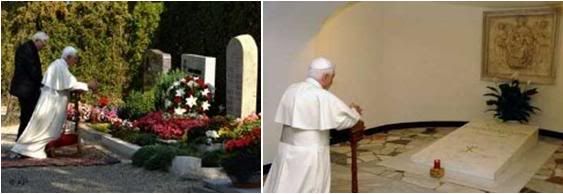
No OR today.
The Vatican Press Office announced that ay 6 p.m. today, Feast of All Souls, Benedict XVI will be visiting
the Vatican Grottoes to pray at the tombs of his predecessors and for all the faithful departed.
[Modificato da TERESA BENEDETTA 02/11/2009 13:08] |
| |
 02/11/2009 12:46 02/11/2009 12:46 |
|
| | | OFFLINE | | Post: 18.783
Post: 1.431 | Registrato il: 28/08/2005
Registrato il: 20/01/2009 | Administratore | Utente Veteran | |
|
 In praise of the medieval Christian thinkers
In praise of the medieval Christian thinkers
In his current catechetical cycle, Benedict XVI has introduced to the public the thought of the great
Christian thinkers who conserved and built on Europe's cultural patrimony in their search for God.
The theologian Pope sees them as models for theologians today.

 OR illustrations of the last 3 papal catecheses. From left, Peter the Venerable; Cistercians listening to Bernard of Clairvaux (inllustrated the 10/28 catechesis); and funeral of Bernard of Clairvaux.
OR illustrations of the last 3 papal catecheses. From left, Peter the Venerable; Cistercians listening to Bernard of Clairvaux (inllustrated the 10/28 catechesis); and funeral of Bernard of Clairvaux.
ROME, November 2, 2009 – At the general audience last Wednesday, Benedict XVI broke away from the pattern of the current cycle. He didn't discuss the figure of a Church Father or a great medieval Christian author, as he has done systematically for a long time. The previous Wednesday, for example, he talked about Saint Bernard of Clairvaux, and the Wednesday before that, about Peter the Venerable, the great abbot of Cluny.
No. This time, Papa Ratzinger's catechesis was a history lesson on theology. He dedicated it entirely to describing twelfth-century Latin theology, which blossomed in the abbeys and cathedrals, and would produce its ripest fruit in the following century, in Saint Thomas Aquinas and Saint Bonaventure of Bagnoregio.
In practice, the written outline of the papal catecheses is prepared by trusted experts with competence in a particular field. Benedict XVI sees the text in advance and enhances it, prunes it, supplements it. In short, he makes it his own. And when he finally reads it to the faithful, he often departs from it even further, improvising. Last winter, www.chiesa reprinted the five catecheses that the Pope dedicated to Saint Augustine, emphasizing the many passages in which he departed from the written text.
The main expert in this area is Inos Biffi, a medieval theology scholar of rare profundity and with a clear writing style, as can be seen in his imposing bibliography (all his books are being published, in magnificent editions, by Jaca Books).
With him, Benedict XVI is less likely to depart from the written text. The impression is that there is a strong harmony between the Pope and this collaborator, both in thought and in manner of expression.
In the catechesis last Wednesday on the blossoming of theology in the twelfth century, one citation is particularly revealing - a book by a Benedictine scholar of the past century, Jean Leclercq, dedicated to medieval monastic theology and entitled L’amour des lettres et le désir de Dieu [Love of learning and the Desire for God].
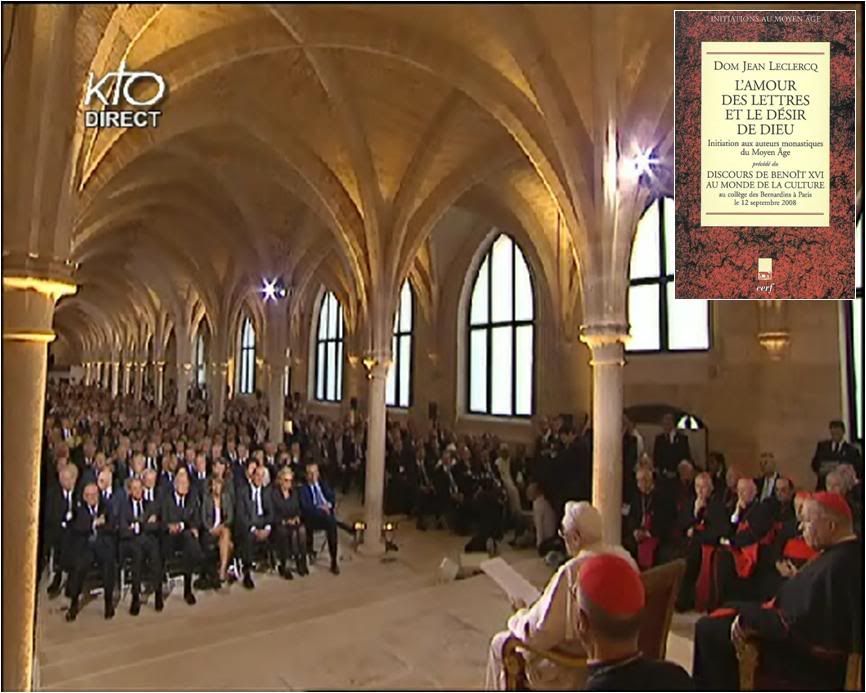 Benedict XVI at the College des Bernardins. Inset: Leclercq's book has been re-issued with the Pope's lectio magistralis as a Preface.
Benedict XVI at the College des Bernardins. Inset: Leclercq's book has been re-issued with the Pope's lectio magistralis as a Preface.
This book is a favorite of Ratzinger the theologian. As Pope, he cited it in one of the most important speeches of his pontificate, delivered on September 12, 2008, at the Collège des Bernardins in Paris, and addressed to the world of culture.
The greatness of medieval monastic theology, as interpretated by Leclercq, Biffi, and Ratzinger, lies in the connection it makes between the search for God and the study of the word, of language, of literature. The search for God and the culture of the word are one and the same, not only in theology but also in spiritual elevation. And they are at the foundation of European civilization.
But alongside monastic theology, scholastic theology also blossomed in the twelfth century, in the cathedral schools. With a powerful emphasis on reason, on fruitful dialogue between "fides et ratio," between faith and reason.
With this lesson on grand medieval theology, it is as if Benedict XVI - being the Pope theologian that he is - wants to draw the guidelines for the theology of today.
[Magister then provides a translation of the Oct. 28, 2009, catechesis - previously translated and posted on this thread in the preceding page.]
[Modificato da TERESA BENEDETTA 03/11/2009 14:41] |
| |
 02/11/2009 14:11 02/11/2009 14:11 |
|
| | | OFFLINE | | Post: 18.784
Post: 1.432 | Registrato il: 28/08/2005
Registrato il: 20/01/2009 | Administratore | Utente Veteran | |
|
 Here's a thoughtful commentary from a Philadelphia lawyer who is not a habitual religious commentator!
Pope Benedict is putting
Here's a thoughtful commentary from a Philadelphia lawyer who is not a habitual religious commentator!
Pope Benedict is putting
the Church on track towards unity
By JAMES G. WILES

Sunday, November 01, 2009
PHILADELPHIA - By coincidence, when word came of Pope Benedict’s initiative towards the Anglicans, I was re-reading Father Basset’s history of the English Jesuits.
The day before, I had viewed "A Man for All Seasons" and recalled the paintings in the London Oratory. One of my prized possessions is a beautifully printed account of the English martyrs of the Order of the Knights of St. John of Jerusalem Hospitaler, a gift of Professor William Tighe of Muhlenberg University. When I took my wife to Ireland for the first time in 1994, we spent more time wandering through ruined abbeys than we did in the pubs.
For someone with that kind of personal background, it was impossible not to think of Psalm 126: “When the Lord turned against the captivity of Sion, then were we like unto them that dream. Then was our mouth filled with laughter.” The music of Thomas Tallis and William Byrd played in my head.
Like the falling of the Berlin Wall in 1989, the possibility that the Catholic church of the English might finally come home to Rome in my lifetime was paralyzing.
I was struck by the notion that, like the Soviets and their allies who’d sought to kill Pope John Paul II, instead had seen their Communist empire collapse around them, the shades of Thomas Cromwell and Henry VIII might now be watching from hell as the Archbishop of Canterbury sat with the Cardinal Archbishop of Westminster and listened to His Eminence announce the Holy See’s terms upon which Anglicans could return en masse to the Catholic fold. Somewhere, William Shakespeare, that recusant Catholic, was smiling.
The Holy Father’s Apostolic Constitution was not, the archbishops agreed, an act of papal aggression. It was, instead, an ecumenical gesture. Like the same Pope’s attempted reconciliation with the breakaway Society of Pope Pius X, it was an act of charity.
It was impossible to keep a straight face.
This is an earthquake. For two reasons:
First, this is Pope Benedict’s latest initiative in what is now clearly a papal policy of trying to rally the vibrant, sacramental Christian churches around the Papacy in response to the collapse of the other mainline Christian churches and the oncoming threat of jihadi Islam, especially in Europe.
As such, by offering concessions in exchange for lost sheep returning to the Church and the Sacraments, the Holy Father is seeking to build up a new Christendom and to gather in the still-faithful remnants of the collapsed Protestant Churches – hierarchy, clergy and laity together.
The intended symbols of this new, united Christendom, in my estimation, will be the Papacy and the Mass, including the newly revived Extraordinary Rite of the Mass, which now under Benedict’s motu proprio, is required to be the liturgy celebrated at all international gatherings. [Well, not really. He wants Latin to be used for Masses with international audiences, but not the extraordinary form necessarily.]
It may be a century before our descendants know if this papal policy is a success. However, the dead end of the Reformation is now apparent for all to see in the spectacle of the American Episcopal Church and the disappearance of the Anglican Church in the United Kingdom.
The break from Rome and fidelity to Scripture and the Sacraments has led precisely nowhere.
There is, thus, every reason for Pope Benedict to seek to sweep together the embers and blow hard upon them. It appears that that’s exactly what he is doing. As with the Easter fire, it will be for later Popes to build this small blaze into a full blown conflagration.
The second possibility is more elusive because we haven’t yet seen the text of the Apostolic Constitution.
Will the new structures contemplated by the Pope and his men establish a precedent for the Orthodox, Lutheran and other Christian churches which have the Mass, are hierarchically-based and sacramentally-centered, to become “sister churches” to Rome? [It doesn't seem so. As an Anglican prelate-turned-Catholic observed, the returning Anglican communities will not be a 'Catholic Church of the Anglican rite', which is the Uniate formula.]
In the Uniate Churches, for instance, Eastern Rite Catholics retain their liturgies, vestments, art, liturgical languages and music, church structures and titles. Yet, some of their patriarchs are also members of the Sacred College of Cardinals.
The answer is that it’s simply too early to tell. A precedent may not even be what is intended.
In the meantime, a trajectory has been established toward unity. And the talking heads of five years ago have been proven wrong.
This 82-year-old piano-playing Bavarian is not who they thought he was. The man who was called Pope John Paul II’s Rottweiler, the feared head of the Holy Office, the “German Shepherd” who, as a teenager, “saw the gates of hell open” and who, as Pope, adopted the name of the Apostle of Europe who had established the monastic system to convert the barbarian invaders and restore Christian civilization to Europe, turns out, instead, to be a uniter.
Indeed, Benedict VII promises to become as central a figure in Christendom as Pope Pius X. May he be as successful.
A light has cut through the darkness and we have something to celebrate. As they come in, whether en masse or one-by-one, let us welcome our Anglican brothers. And let us learn from them, too.
And the drumroll goes on for the Pope of Christian Unity. This was yesterday's pastoral note for All Saints' Day from the pastor of the church I have attended for Sunday Mass since it started last January 4 to offer the Missa Cantata of the Extraordinary Form at 9 a.m. Sunday mornings. As luck would have it, he is one of the more famous Anglican priests turned Catholic.
 From the Pastor
From the Pastor
Fr. George Rutler
Nov. 1, 2009
The expression "a living saint" can be misleading. Certainly, we have encountered people in our own lives who fit that description, as best as we can judge. The Holy Church makes the final decision about saints. We celebrate them especially on All Saints’ Day, and on All Souls’ Day, we pray for our loved ones who are drawing more closely into the aura of holiness.
The saints on the calendar are only the tip of the iceberg, and most of the saints who have ever existed are known to God alone. Perhaps churches should have a shrine to "The Unknown Saint" quite as we have a Tomb of the Unknown Soldier. All Saints’ Day is rather like that.
My point, though, is that there is no such thing as a dead saint. [good point] There are saints alive now, and there are saints who have physically died, but all are alive in Christ and they are "busy" in heaven, to use a temporal metaphor.
Some saints capture the popular imagination more in one generation than in another. For instance, St. Simon Stylites was admired in Syria in the fifth century for spending most of his life seated on top of a pillar. That is not a useful model for our day, although some may still remember Flagpole Kelly, and not long ago thousands of New Yorkers went to watch a man spend a week on top of a column up the street in Bryant Park.
Millions are drawn to Padre Pio, and some are compelled by an unmeasured fascination with his miraculous spiritual gifts, which were blessings indeed, rather than emulating his heroic humility and discipline.
There remains an astonishing cult of St. Thérèse of Lisieux. She was almost the reverse of St. Pio: totally unknown in her earthly lifetime, and accomplishing nothing conspicuous to her contemporaries. She would have remained such had not her spiritual writings been discovered and published.
Perhaps she fascinates precisely because in just barely 24 years on earth, she did the most ordinary things with most extraordinary joy. Whenever her relics are taken on pilgrimage to foreign lands (not to mention the one that was taken on a space shuttle), hundreds of thousands pour out to pray by them. This happened most recently in England, where the media were confounded by the huge crowds.
Concurrent with that phenomenon, there were astonishing developments in long-moribund Christian life there, not least of which was the announcement of the first papal state visit to Britain and the expected beatification of John Henry Newman, who predicted a "Second Spring" of Faith in England.
Then came news of an Apostolic Constitution, which will provide a unique canonical structure to welcome those desiring union with the Catholic Church.
Pope Benedict XVI, who well deserves the title "The Pope of Unity," has shown the power of the intercessions of the saints.
[Modificato da TERESA BENEDETTA 02/11/2009 18:34] |
| |
 02/11/2009 22:29 02/11/2009 22:29 |
|
| | | OFFLINE | | Post: 18.787
Post: 1.435 | Registrato il: 28/08/2005
Registrato il: 20/01/2009 | Administratore | Utente Veteran | |
|


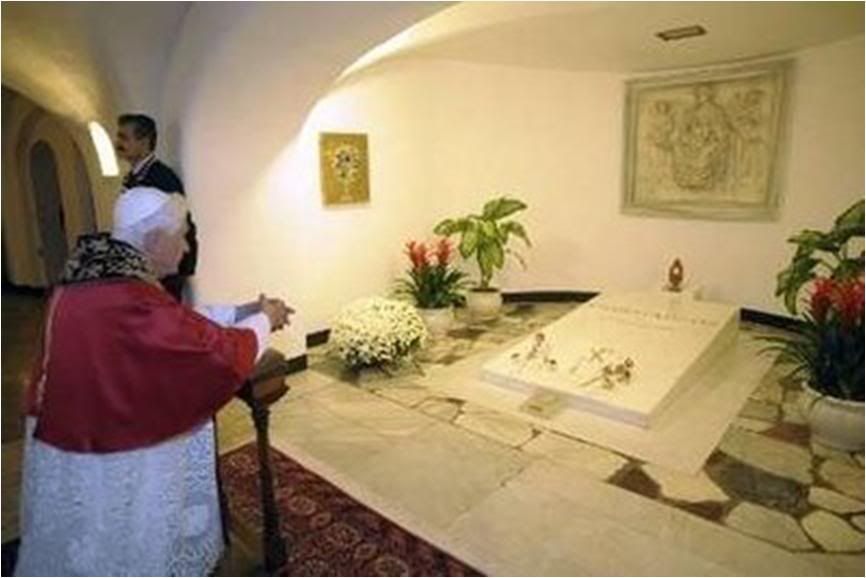
At the tomb of John Paul II.
 Pope Benedict prays at the Vatican Grottoes
Pope Benedict prays at the Vatican Grottoes
for predecessors and the faithful departed
Translated from
the Italian service of

Nov. 3, 2009
When the Church commemorated all the faithful departed yesterday, Pope Benedict XVI renewed a traditional ceremony at the Vatican Grottoes where many of his predecessors, starting with the Apostle Peter himself, are buried.
Descending to the grottoes below St, Peter's Basilica, the Pope offered an intense and solemn prayer:
"In these Vatican Grottoes, let us entrust to the mercy of the Father those who are buried here and await the resurrection of the body, particularly Pope John Paul II and the other Supreme Pontiffs who carried out their service as Pastors of the Universal Church, that they may be participants in the eternal liturgy of heaven".
During the prayer service, a passage was read from the Letter of St. Paul to the Philippians in which the Apostle of the Gentiles exhorts Christians to await the coming of the Savior who will transfigure our poor mortal bodies in order to unite us to his glory.
In his prayer for all the faithful departed, the Pope had a special thought for those who were victims of every form of violence, with the hope that their sacrifices may hasten the coming of an era of brotherhood and peace.
[Modificato da TERESA BENEDETTA 03/11/2009 14:39] |
| |
 03/11/2009 12:57 03/11/2009 12:57 |
|
| | | OFFLINE | | Post: 18.788
Post: 1.436 | Registrato il: 28/08/2005
Registrato il: 20/01/2009 | Administratore | Utente Veteran | |
|
 Tuesday, Nov. 3
Tuesday, Nov. 3
 ST. MARTIN DE PORRES (Peru, 1579-1639)
ST. MARTIN DE PORRES (Peru, 1579-1639)
Dominican brother, 'Saint of the Broom'
Born to a Spanish father and black Panamanian
mother, he spent most of his life in medical
apostolate to the poor. Mystic and miracle maker
even in life. Friend to St. Rose of Lima.
Beatified 1867, canonized 1962.
OR for 11/2-11/3/09:
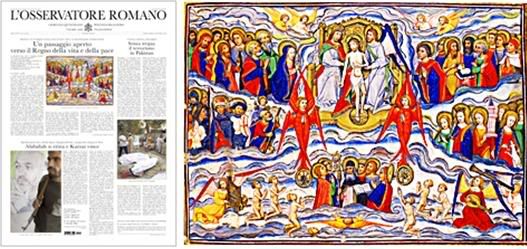 Illustration: The glory of Paradise, 15th-cent folio, Valenciennes, Bibliotheque Municipale.
Illustration: The glory of Paradise, 15th-cent folio, Valenciennes, Bibliotheque Municipale.
At the Sunday Angelus, Benedict XVI speaks of the Feasts of All Saints and All Souls:
'An open way towards the Kingdom of life and peace'
He also recalls the 10th anniversary of a historic joint declaration by Catholics and Lutherans
on the doctrine of justification. Other Page 1 stories: No respite in terrorism in Pakistan;
in Afghanistan, Hamid Karzai's reelection is proclaimed after his rival rejects a runoff.
No events scheduled for the Holy Father today.
A news conference was held by Archbishop Antonio Maria Veglio, president of the Pontifical Council
for the Pastoral Care of Migrants and Itinerant Workers on the VI World Congress on such pastoral care
to take place at the Vatican Nov. 9-12, on the theme "A pastoral response to the phenomenon of
migration in the time of globalization".
[Modificato da TERESA BENEDETTA 03/11/2009 14:08] |
| |
 03/11/2009 20:06 03/11/2009 20:06 |
|
| | | OFFLINE | | Post: 18.793
Post: 1.441 | Registrato il: 28/08/2005
Registrato il: 20/01/2009 | Administratore | Utente Veteran | |
|


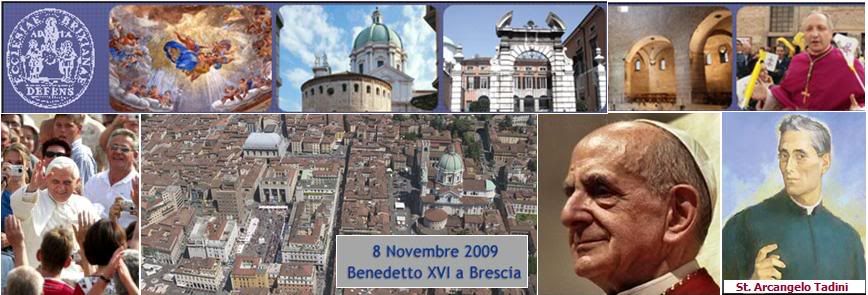 Papa Ratzinger to pay homage
Papa Ratzinger to pay homage
to the Pope who named him cardinal
by ITALIA BRONTESI
Translated from

Nov. 1, 2009
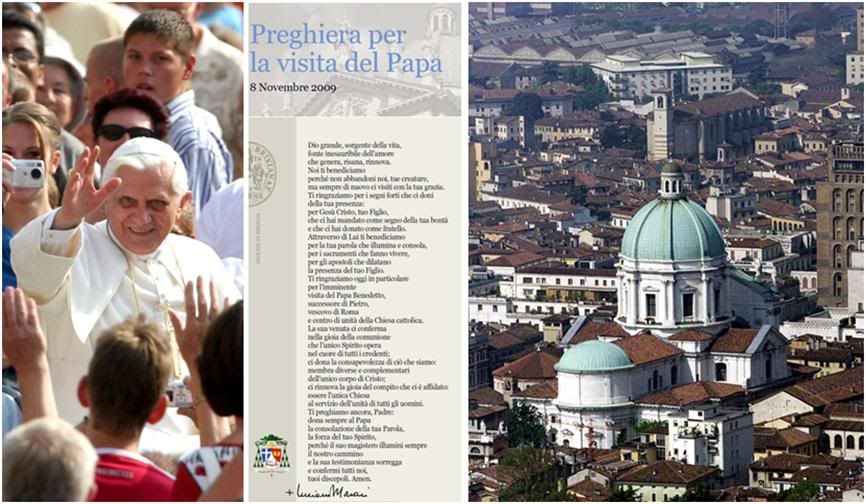
BRESCIA - Pope Benedict XVI's visit to Brescia was originally intended to take place in late 2008, the 30th anniversary of the death of Pope Paul VI. But the papal schedule could not accommodate it till this year, and so the Bavarian Pope will be in Brescia on November 9, in the footsteps of the Pope who was born Giovanni Battista Montini in the suburb of Concesio.
The visit will be a total of ten hours from the time he arrives by helicopter at the military airbase of Ghedi at 9:30 a.m. till he returns to Rome.
His first stop from the airport will Be Botticina Sera, where he will venerate the remains of St. Arcangelo Tadini, who founded the Congregation of Worker Sisters in the early 20th century and was canonized last April by Benedict XVI himself.
A 10:15, he will arrive at the Cathedral of Brescia where he will celebrate Mass at the Piazza Paolo VI facing the church, which can accommodate 12,000. He will also lead the recital of the Angelus after the Mass.
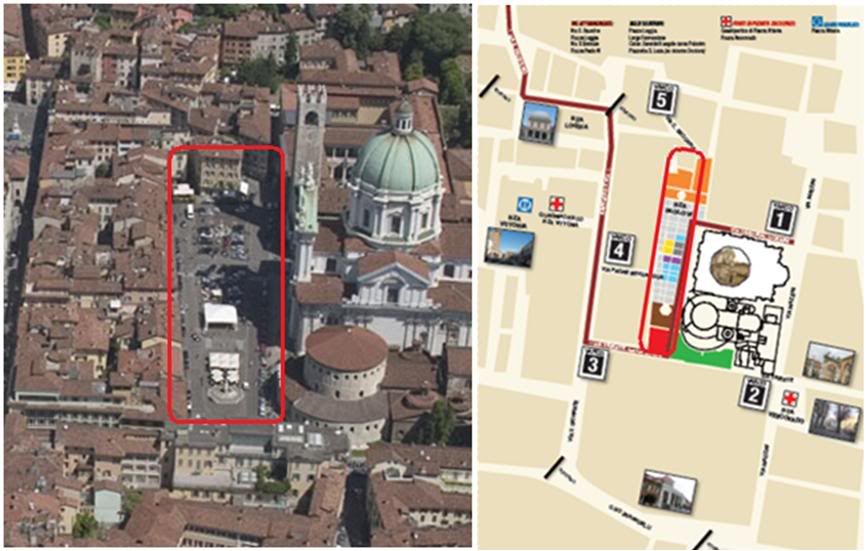
He will then have lunch and a brief midday rest at the Centro Pastorale Paolo VI, before leaving in the afternoon for Concesio, Paul VI's birthplace. he will be travelling the 40 kilometers distance from the city in the Popemobile.
In Concesio, he will visit the home where Papa Montini was born and the church where he was baptized, then proceed to the Istituto Paolo VI where he will inaugurate the new headquarters - the immediate occasion for this visit.
The Institute is a center of study and research on the works and writings of Paul VI. The Pope will also preside at the awarding of the sixth Paul VI International Prize which is being awarded this year to Sources Chretiennes, the editorial series founded in 1942 by French theologians Henri de Lubac and Jean Danielou, which has been dedicated to the recovery of early Christian texts, especially those of the Fathers of the Church, and today comprises some 350 volumes.
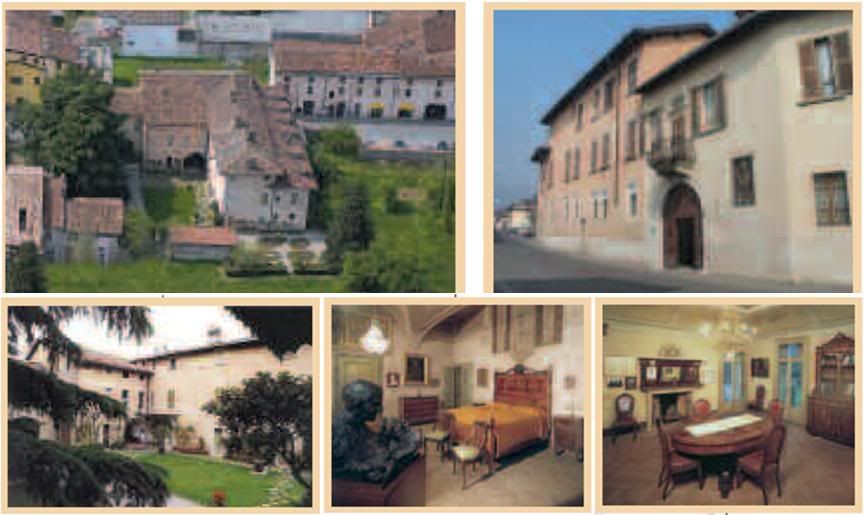 Photos show, clockwise from top left, aerial view of the Montini property; the street entrance to the home; the dining room; the bedroom where the future Pope was born; and the house seen from the inner courtyard.
Photos show, clockwise from top left, aerial view of the Montini property; the street entrance to the home; the dining room; the bedroom where the future Pope was born; and the house seen from the inner courtyard.
The Montini family home is located next to the modern complex of the Institute. Some rooms have been kept as they were at the time of the future Pope's birth, including the Empire-style bedroom in which his mother Giuditta delivered.
Cardinal Joseph Ratzinger was in Brescia in March 1986 when he gave a lecture on 'Theology and the Church' at a conference sponsored by Communio, the international theological journal founded by a group of former Vatican II theologians including Hans Urs von Balthasar and Joseph Ratzinger. Twenty-three years later, he will be back as Pope.
"The significance of the visit is clear," said Mons Luciano Monari, Bishop of Brescia, at a news conference on Saturday, with the mayor of Brescia, Adriano Paroli, and the president of the province, Daniele Molgora.
"Thirty-one years have passed since the death of Paul VI. This visit is basically a homage to him, a remembrance of his pontificate, of the Second Vatican Council, and Benedict XVI's own links with the late Pope", who had named in March 1977 Joseph Ratzinger, then a university professor, to be Archbishop of Munich-Freising, and then less than two months later, made him a cardinal.

"The choice of theologian Ratzinger would seem to have been a strategic decision by Paul VI", said Mons. Monari, " to have someone in the Church hierarchy who could represent the Council in a fully informed and balanced manner, a theologian who was known to be open-minded as well as well-rooted in the Christian tradition".
The Bishop also said that the visit serves "to highlight the
communion between the Church of Rome and the Brescian church, and to reflect together on the mission of the Church".
"The Magisterium of Benedict XVI," he continued, "is very much aware of modernity, to the life of man in the contemporary world, and in this perspective, holds up to our sight the fundamental values of the faith and of the Christian tradition, the values that man should have, and the collaboration between faith and reason. Whoever cares about human destiny needs to reflect on these."
When Cardinal Ratzinger
came to Brescia in 1986
by Fr. Antonio Maria Sicari, OCD
Translated from

I was the editor of the Italian edition of the international Catholic magazine Communio from 1981 to 1990. To facilitate my work, the editorial headquarters was moved to Brescia, into the Catmelite convent of St. Peter in Castello.
It was at that time that we decided to invite Cardinal Joseph Ratzinger to Brescia, in order to give a public lecture that would relaunch the ideals of Communio, so dear to him since the magazine was founded.
He was a guest at the convent, where we spent the morning hours together and had a festive lunch along with some lay faithful who had been invited. I remember that we were all pleasantly surprised by his simplicity and gracious courtesy.
And so, on the afternoon of March 22, 1986, more than 2,000 people were able to hear him at the beautiful Vanvitelliano Hall of the Palazzo Loggia, where he delivered a long and rather demanding lecture on "Theology and the Church".
To present him to the public, all I needed to do was to recall that he had written in his famous 'Introduction to Christianity': "The Church does not make its maximum presence felt where it is organizing, reforming itself, reacting and setting course; but it is best felt in those who believe in all simplicity, receiving the gift of faith which becomes the source of life for them."
I knew that the concept of 'believing in all simplicity' was particularly dear to him, because he had stated many times: "The Christian believer is a simple person - and bishops should safeguard the faith of these people from the power of the intellectuals".
Thus did the Cardinal himself perceive and live his difficult mission in Rome to "guard the doctrine of the faith and its practices throughout the Catholic world".
At that time, the bookstores did not yet offer all those 'investigations' and 'analyses' of Jesus Christ to which we have by now become weary of their 'all-knowing' presumptuousness.
In his Brescia lecture, the cardinal already warned: "Every discourse on Jesus which claims to be purely empirical (one could say 'purely historical') remains stuck in a decidedly absurd tangle of misunderstandings".
The concatenation of his thoughts followed each other with fascinating rhythm:
"A Church without theology becomes impoverished and blind; and a theology without a Church dissolves in arbitrariness".
"Since there is no theology without faith, there can be no theology without conversion."
"Theology becomes more possible, as faith itself becomes truly an experience."
"The connection between theology and holiness is supported by the testimony of history."
The cardinal's words descended calm and decisive on the congregation, as his lecture, in an increasingly persuasive manner, showed him to be a theologian enamored with Christ who could say with St. Paul, "I, but no longer I!"
He concluded his leacture with an image that was not without tenderness, commenting on an ancient Roman bas relief, in which a small but courageous white puppy (representing theology, or the true theologian) defends the Lamb from the attack of a lion ('pure reason, untrammelled and despotic').
More than 23 years have passed since then. And shortly, robed in white and with the name of Benedict XVI, he will return among us, to this city already so rich with memories of Paul VI, in order to give comfort once more to "the faith of the 'little folk' and the 'simple faithful'.
He is coming back to remind everyone this time, not just theologians, that the Christian is himself, and happily so, when "he does not pretend to make it on his own but allows himself to receive what he most needs".
The diocesan press office for the visit has made available the Cardinal's lecture - 10 pages of closely written typescript - on "Theology adn the Church", which I hope to be able to translate before Sunday, Unfortunately, no photos of the 1986 event have been made available.
[Modificato da TERESA BENEDETTA 04/11/2009 02:28] |
| |
 04/11/2009 11:12 04/11/2009 11:12 |
|
| | | OFFLINE | | Post: 18.795
Post: 1.443 | Registrato il: 28/08/2005
Registrato il: 20/01/2009 | Administratore | Utente Veteran | |
|
 Wednesday, Nov. 4
Wednesday, Nov. 4
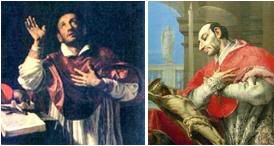 ST. CARLO BORROMEO (Italy, 1538-1584)
ST. CARLO BORROMEO (Italy, 1538-1584)
Cardinal, Archbishop of Milan, Church Reformer
Nephew of Pope Pius IV, he was named cardinal
when he was only 22, but his abilities were
evident, and he set about to carry out Church
reforms at the start of the Counter-Reformation.
Active in the Council of Trent, he was responsible
for much of the Tridentine Catechism. He served
the poor directly during a plague and died young.
He was canonized in 1610.
OR today.
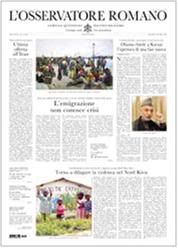
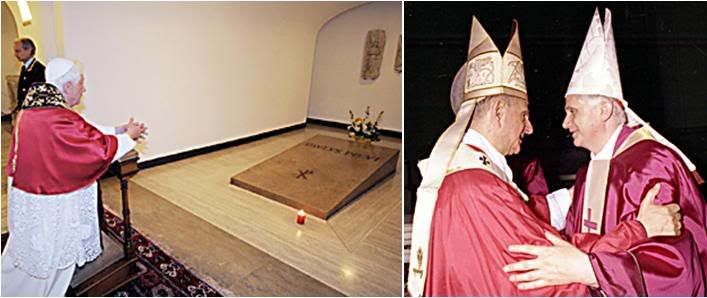
No Papal story on Page 1. Inside, a brief item on the observance of All Souls Day in the Vatican Grottoes led by the Holy Father, and
a long interview with the Bishop of Brescia on the ties between Benedict XVI and Paul VI, to whom the Holy Father pays homage in
his visit to the late Pope's hometown on Sunday. Page 1 stories: Last offer to Iran in international attempts to regulate its nuclear
program; President Obama calls on reelected Afghan President Karzai to start a new phase; a report on growing emigration patterns;
and new violence in the Congo's North Kivu.
THE POPE'S DAY
General Audience today - The Holy Father contrasted 'theology of the heart" to 'theology of reason' as
embodied by St. Bernard of Clairvaux and the scholastic monk Abelard.
NB: I have to be out from 6 a.m. today so I will not be able to post anything for the next several hours.
[Modificato da TERESA BENEDETTA 07/11/2009 18:40] |
| |
|
|
|
|